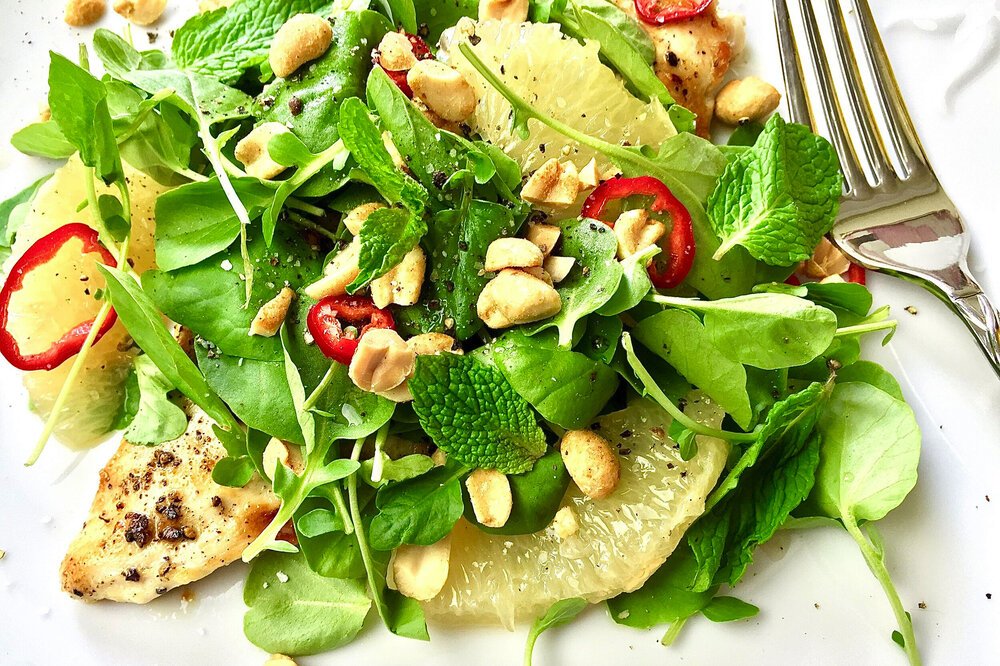
Spring has finally sprung, serving as a seasonal indicator it's time to switch from comforting winter dishes to lighter, more figure friendly fare. As you might imagine, here in South Florida citrus plays a large role in our Springtime cuisine. Luckily, we're able to source many types of citrus locally, so when I came across this recipe for Thai Pomelo Salad (Dtam Som Oo), it peaked my interest since it incorporated the deliciously exotic pomelo.
Also known as shaddock, pummelo, Chinese grapefruit, or lusho fruit, the pomelo is native to Southeast Asia and is the largest known citrus fruit. It is an ancestor of the grapefruit and over the years, was introduced to North America where it is now grown in many states including Texas, California, Arizona and Florida.

Pomelos are the largest known citrus fruit
The large fruit tastes like a milder version of a grapefruit, which is slightly sweeter and not quite as acidic. If you happen to crave this pomelo salad outside of its season (December-April in Florida) you can easily substitute grapefruit with delicious results.
I wanted to turn this salad into a dinner recipe so I added chicken to make it a little more substantial. I simply pounded a few chicken breasts flat, seasoned them with olive oil, salt and pepper and then grilled them on my grill pan. To serve, I topped each cooked chicken breast with a large handful of watercress, pomelo wedges, dressing, mint leaves and peanuts. The dressing is CRAZY flavorful and gives this light, healthy dish plenty of personality.
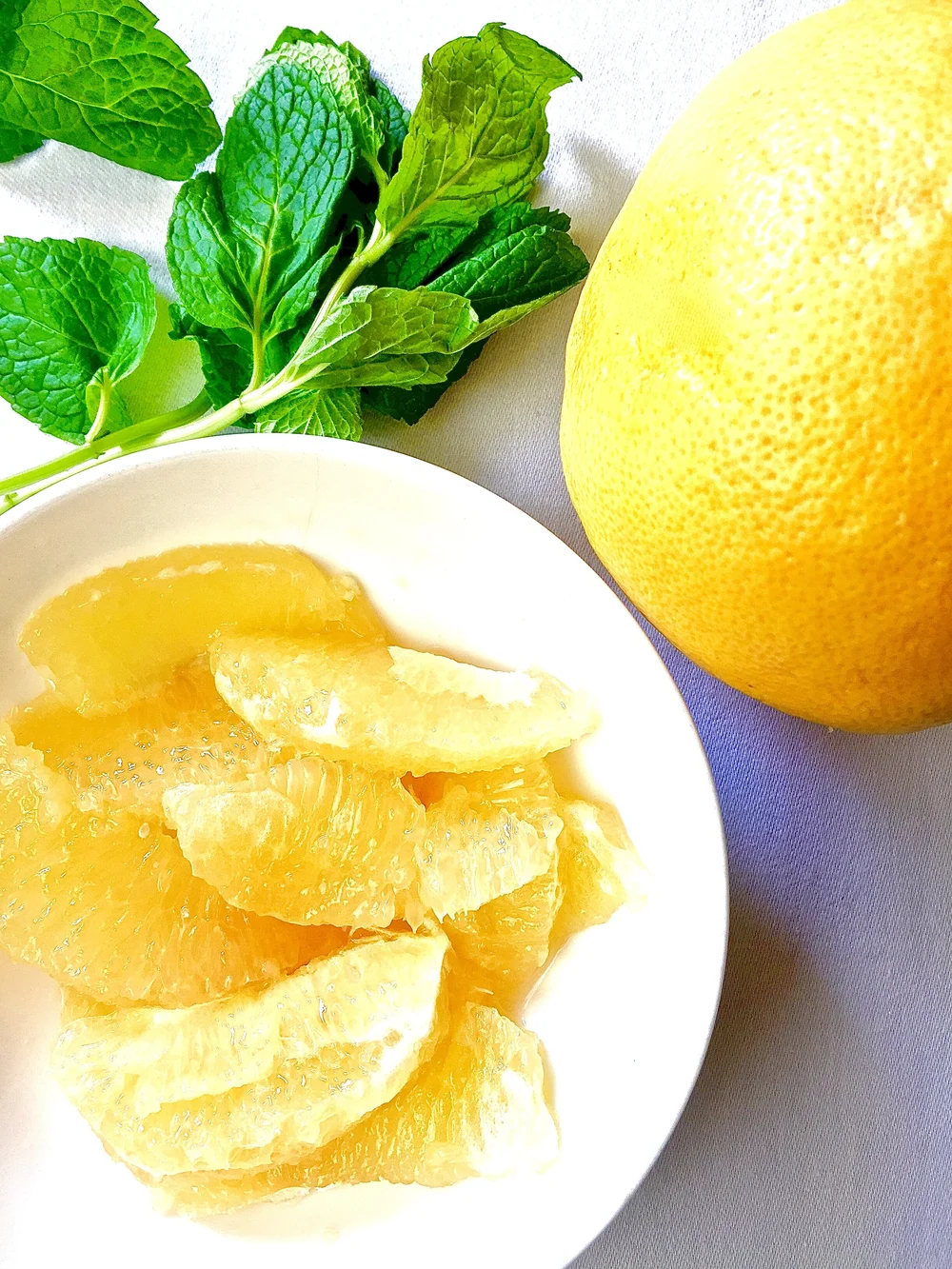
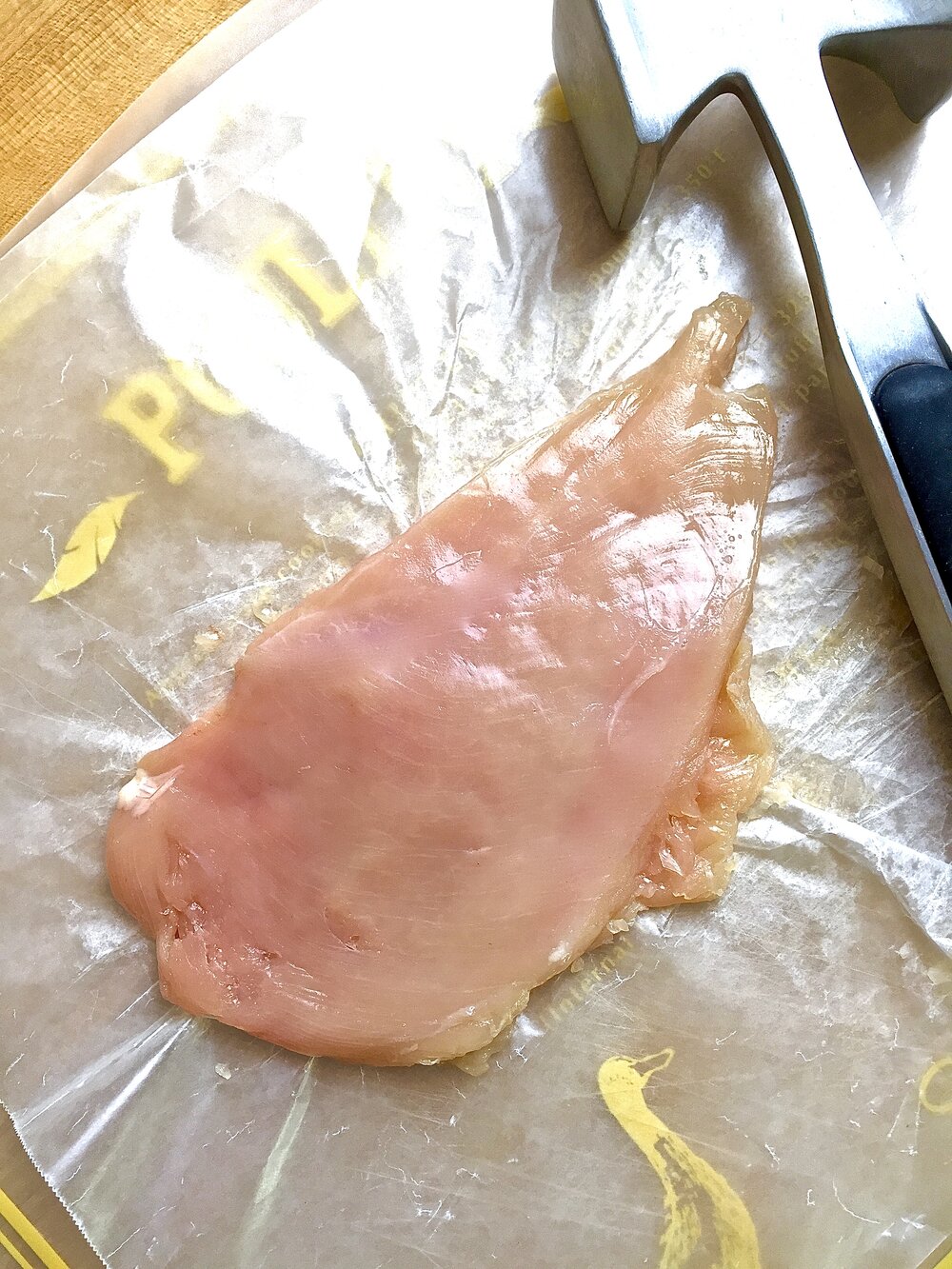
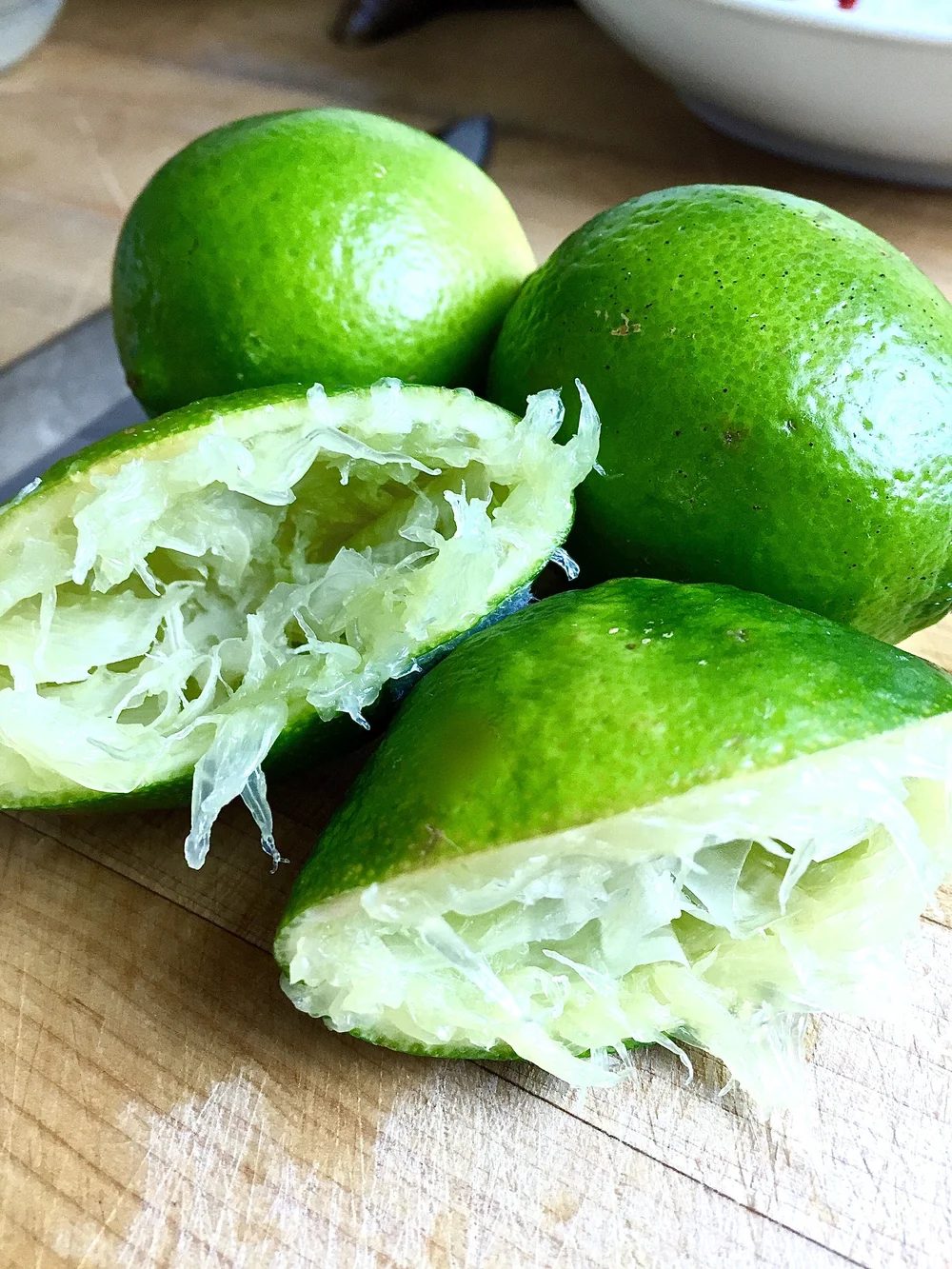
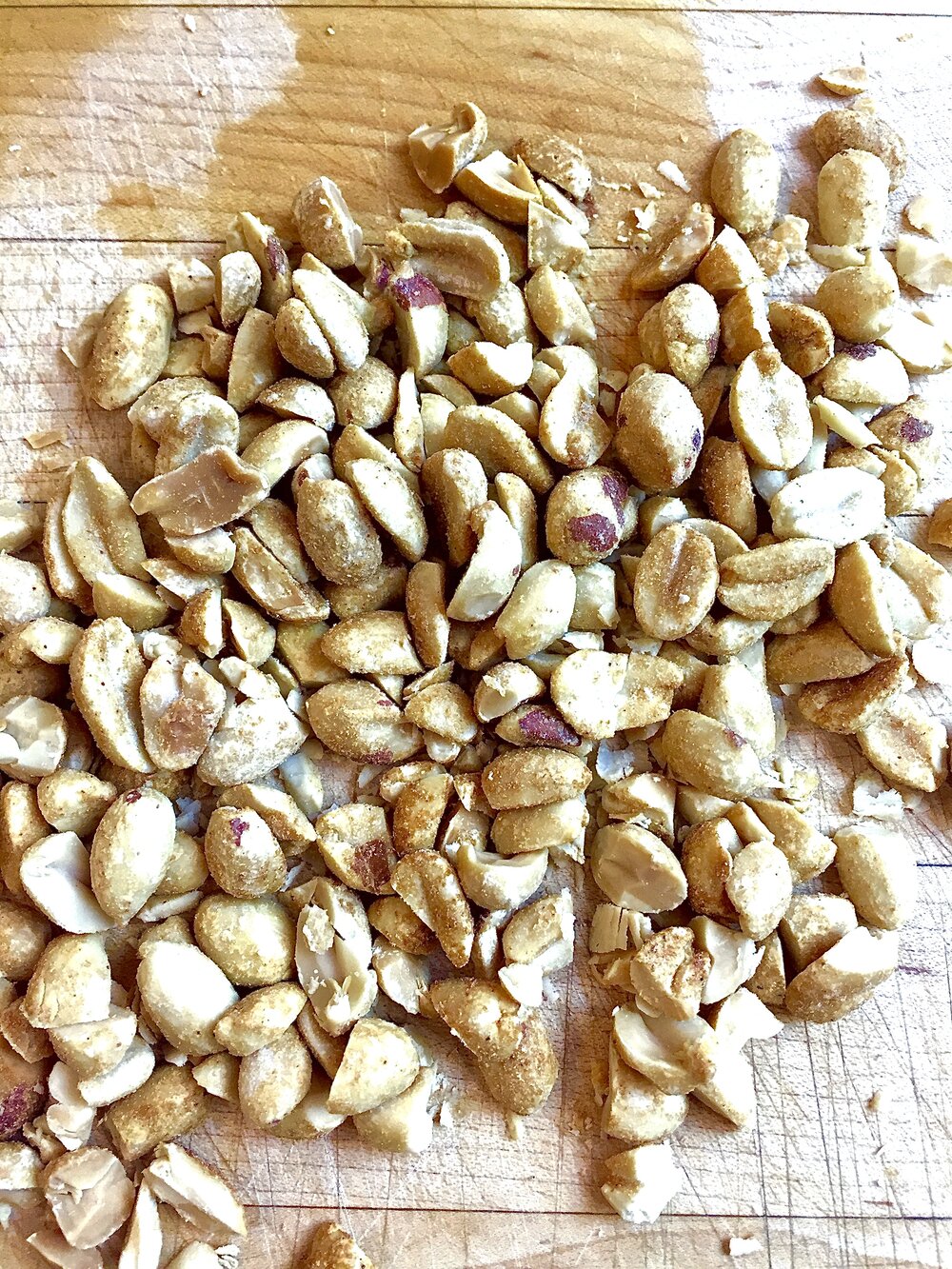
A word of advice, slicing a citrus fruit into "supremes" can take a little practice to master. It involves separating the fruit into segments and removing the peel, pith and outer membranes. For a quick instructional video from Iron Chef Michael Symon on how to perform this culinary technique, please click here.
I highly recommend using a very sharp knife to supreme your citrus and be sure to place your fruit in the fridge for at least thirty minutes prior to slicing - it will make the job MUCH easier. Once you complete this part of the prep, assembling the salad is a TOTAL breeze!
To pair with the Thai Chicken and Pomelo Salad, I love a white wine with plenty of personality like the Château Pesquié Terrasses Blanc ($16) from France's Southern Rhone Valley. This delicious blend of 70% Viognier, 15% Roussanne, and 15% Clairette is delightfully floral, fresh and fruity with notes of honeysuckle, white peach and pear.
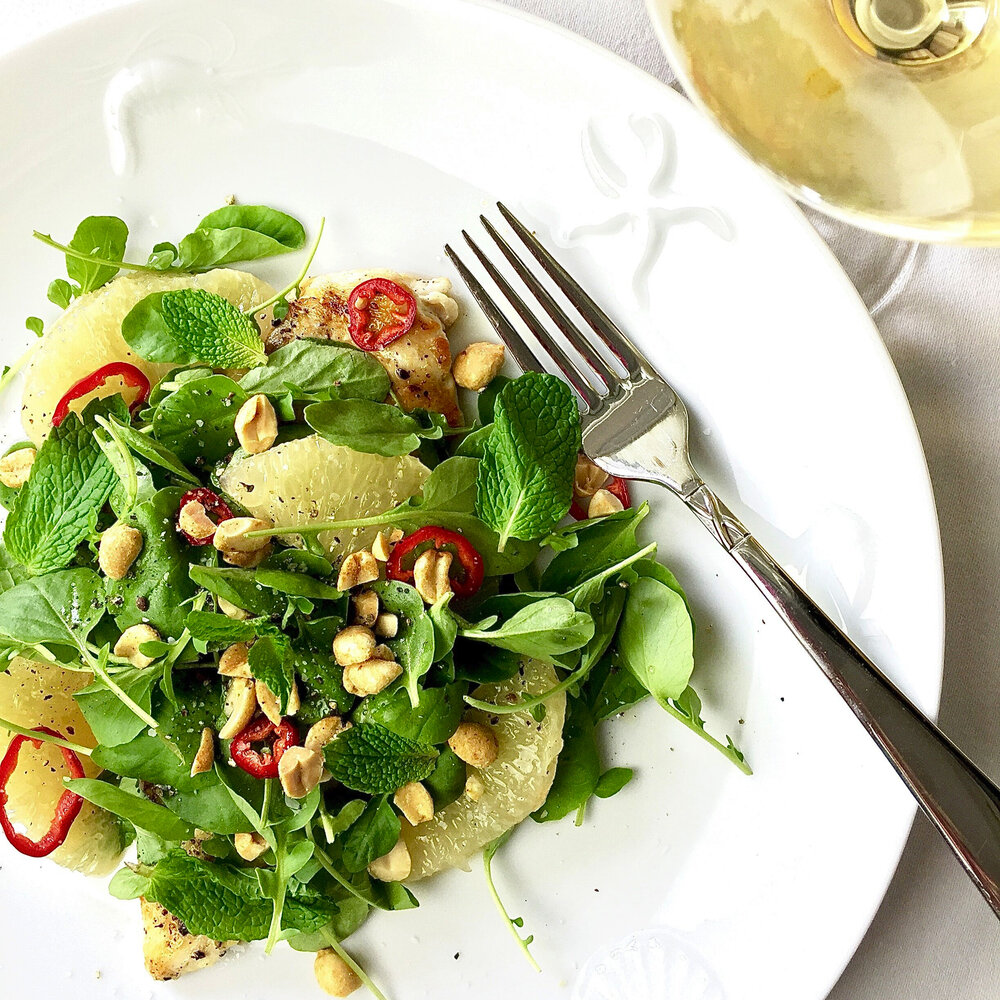
Winemakers Alexandre and Frédéric Chaudière fermented it entirely in stainless steel and concrete vats to preserve the wine's fresh fruit aromas and flavors which complement the flavors of the dish beautifully! What are YOUR favorite farm stand finds for Spring? From asparagus to watercress there are SOOO many good ones to savor and enjoy so please do tell in the comment section below.
print recipe"FAST + FABULOUS: THAI CHICKEN + POMELO SALAD”
Author: Stephanie Miskew | The Glamorous Gourmet (adapted from Saveur Magazine - March 2014)
Serves: 4
Pair with a refreshing white wine like a Cotes du Rhone Blanc from France or Sauvignon Blanc from New Zealand
INGREDIENTS
1/4 cup Thai fish sauce
2 Tbsp. sugar
1 Tbsp. fresh lime juice
1-2 Pomelos depending on size (or 2 grapefruit), peeled + supremed
2 fresh red Thai chiles, thinly sliced
1 clove garlic, finely chopped
1 cup trimmed watercress
1/3 cup roughly chopped peanuts, lightly toasted
20 fresh mint leaves
4 boneless, skinless chicken breasts, pounded thin
INSTRUCTIONS
Drizzle chicken breasts on both sides with olive oil and then season with salt and pepper.
Preheat a grill pan or outdoor grill to medium-high heat and lightly brush grates with olive oil. Cook the chicken breasts approximately 3-4 minutes per side until done and set aside.
Whisk fish sauce, sugar, lime juice, chiles, garlic, and 1/4 cup water in a bowl and set aside.
Plate chicken and top with the watercress. Scatter pomelo or grapefruit sections over the salad, spoon on the dressing and top with the chopped peanuts and mint leaves.
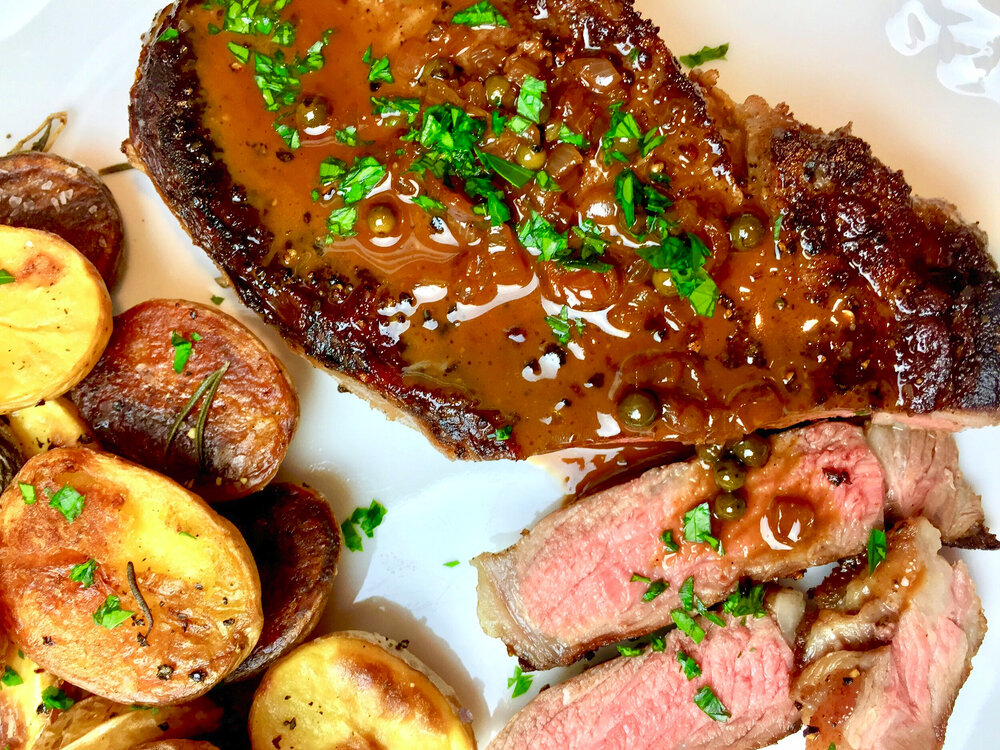
If you're looking for the perfect dish to seduce your Valentine this year - look no further! My recipe for spicy, succulent Steak au Poivre and savory Roasted Rosemary Garlic Potatoes paired with a sensual, seductive red wine ensures a Valentine’s Day filled with endless possibilities
Steak au Poivre is a classic French dish that consists of flavorful pan roasted steak, usually filet mignon, seasoned with peppercorns and then topped with a delightfully creamy, peppercorn-Cognac sauce. The traditional accompaniment is pommes frites, crispy thin french fries, which are essential for mopping up all the mouth-watering pan sauce. I've made a few small tweaks to this classic recipe that have upped the deliciousness factor and made it perfect for satisfying your ravenous Valentine.
While you can use filet mignon in this recipe, I prefer the decadent flavor and superior texture of a juicy, well-marbled New York strip. But feel free to use whatever cut of steak you prefer in this recipe for Steak au Poivre à Deux, which is specifically tailored for two.
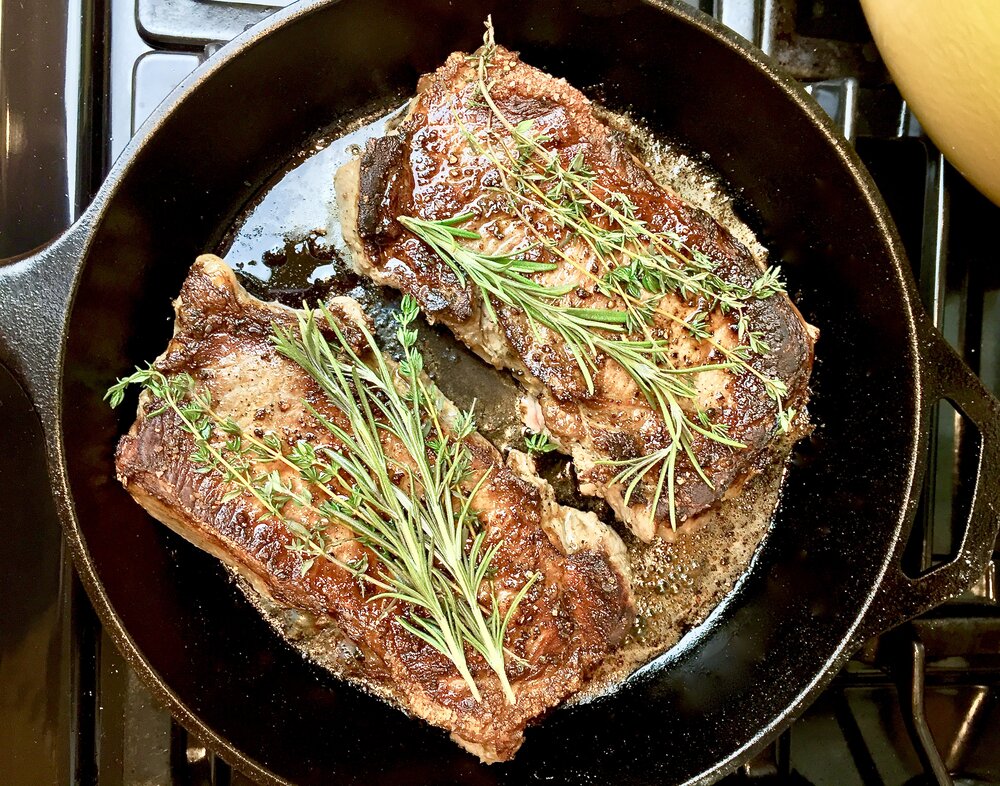
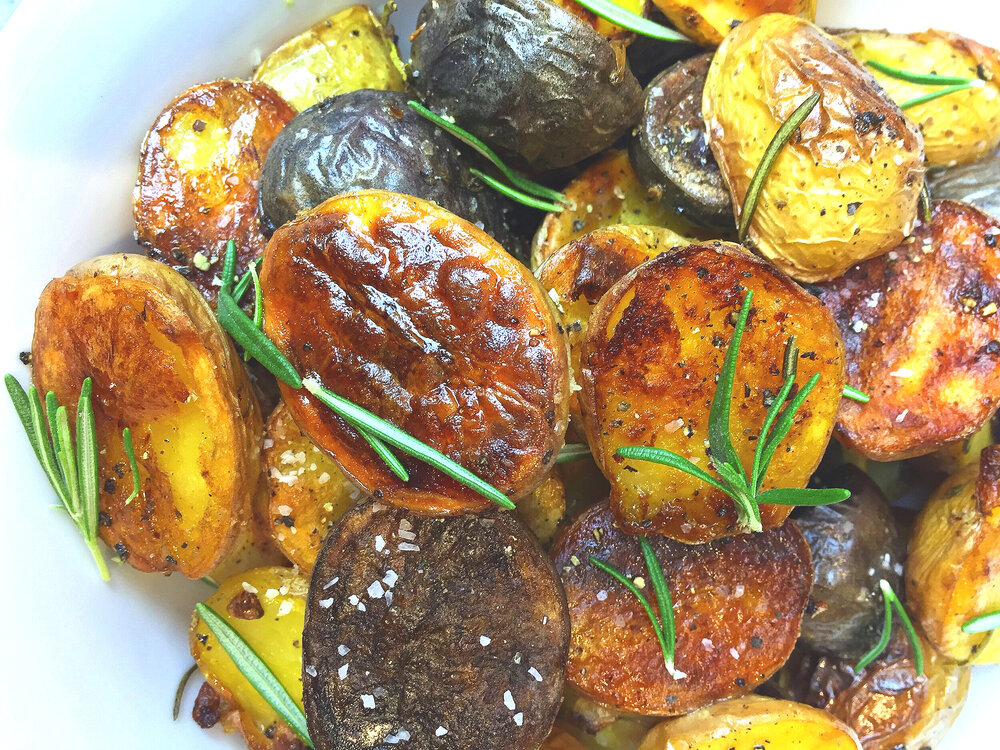
You can also adjust the amount of black pepper to suit your tastes but the sauce also calls for green peppercorns in brine - PLEASE don't skip this ingredient! You might have to make a trip to the gourmet grocery store (I found them at Fresh Market) but it IS Valentine's Day after all and it really adds such amazing flavor to the sauce.
Instead of pommes frites, I've substituted Roasted Rosemary Garlic Potatoes which are incredibly flavorful, easier to make and healthier than fried frites. More importantly though, they are even more effective at mopping up the mouth-watering sauce. Can you tell I'm obsessed with the sauce?!?
And a word of caution when making this recipe, please be sure to remove the pan from the heat when adding the Cognac and immediately after flaming it. The flames may shoot up pretty high (see photo above) but don't panic, they subside quickly. So while you're dazzling your lover with your pyrotechnic skills, just take a few deep yoga breaths as the Cognac quickly burns off.
And be sure to taste the sauce towards the end of cooking and adjust the seasoning if necessary. If you find it too salty, just add a bit of water and/or more cream (yes!) to thin it out which should do the trick.
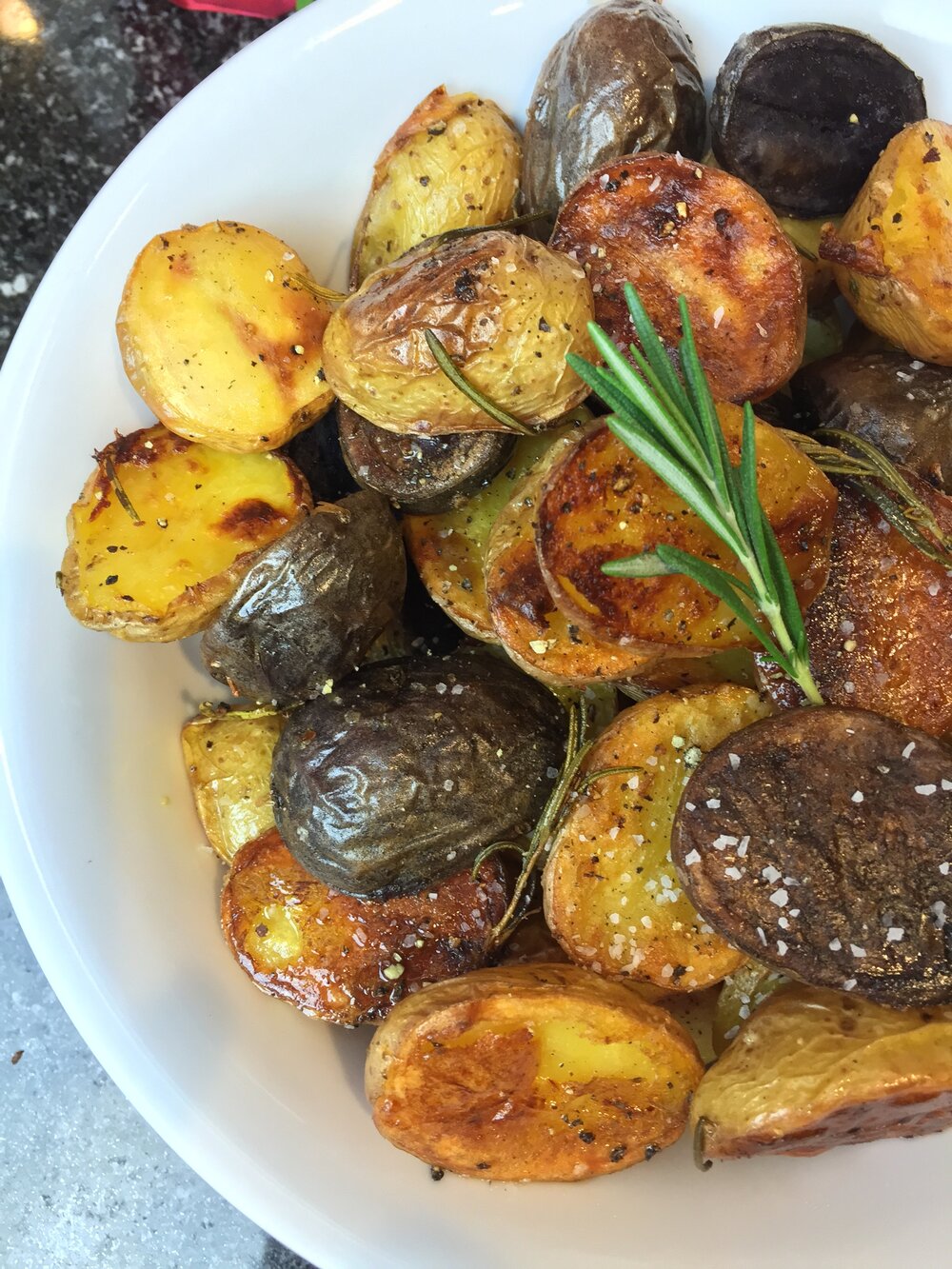
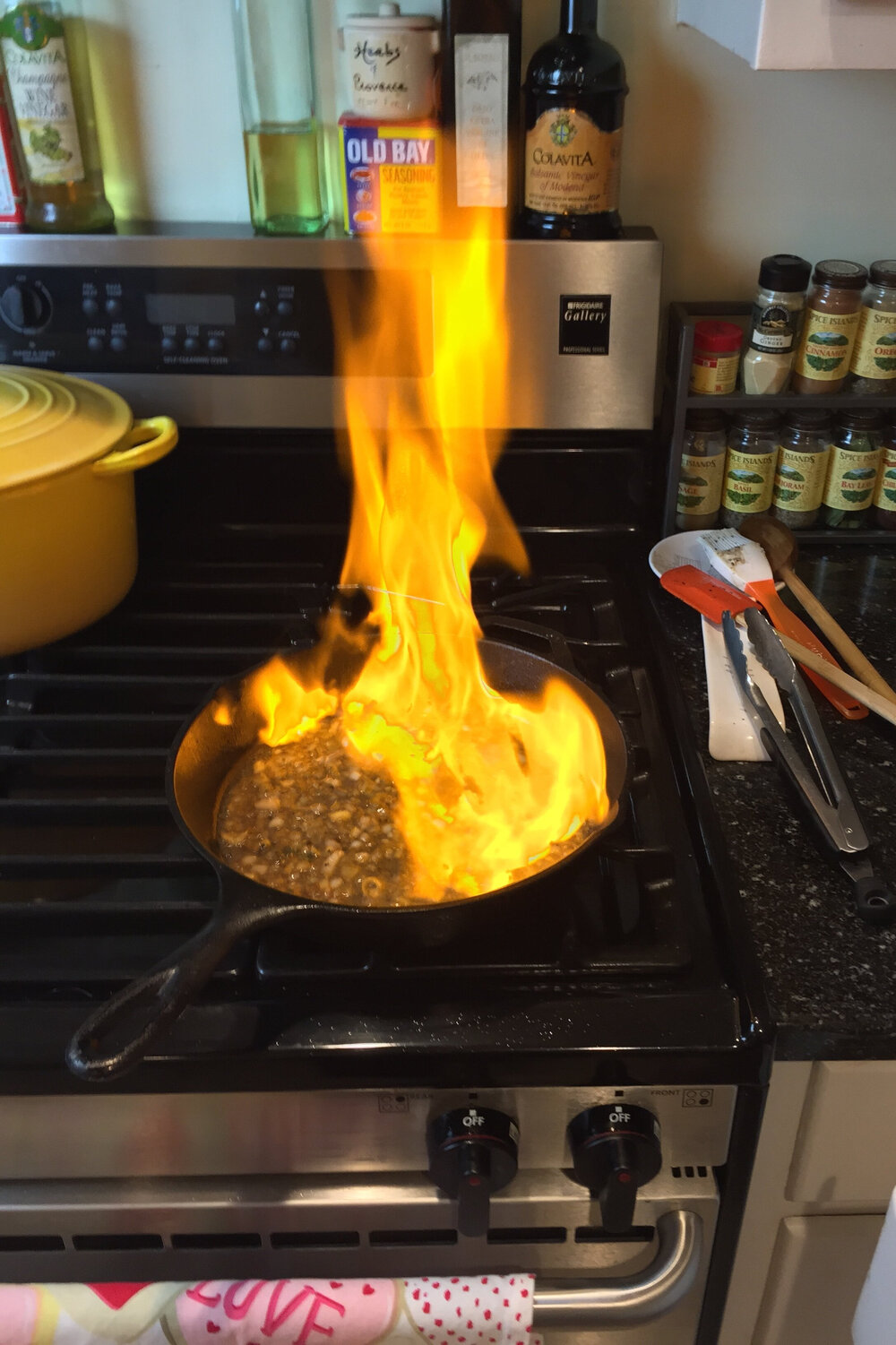

And as far as a wine pairing goes, a big, bold California Cabernet Sauvignon is perfect with this dish! The bold flavors + firm tannins found in Cabernet will stand up nicely to the steak and enhance its flavors perfectly. Some of my favorites include:
Atalon Napa Valley Cabernet Sauvignon ($40): A full-bodied Bordeaux blend that includes all five Bordeaux varieties (76% Cabernet Sauvignon, 15% Merlot, 5% Malbec, 3% Petite Verdot + 1% Cabernet Franc) and exhibits enticing notes of plum, black currant, spice and pepper with chewy tannins and a long, lingering finish.
Darioush Signature Napa Valley Cabernet Sauvignon ($75): This hedonistic incarnation of 100% Cabernet Sauvignon from Darioush Khaledi is sure to make your Valentine swoon with its lush, mouth-filling flavor including layers of black currant, blackberry, cassis, graphite + cocoa accompanied by polished tannins + a truly savor worthy, spice tinged finish.
Mt. Brave Cabernet Sauvignon Mt. Veeder ($100): Vinous mountain man + winemaker Chris Carpenter specializes in crafting red wines from glorious mountain grown fruit + this delightful Cabernet (88% Cabernet Sauvignon, 6.5% Cabernet Franc, 3% Merlot, 1.5% Petit Verdot + 1% Malbec) features rugged tannins softened by notes of ripe black fruit including blackberry, boysenberry and plum accentuated by star anise spice + violet.
But if Cabernet Sauvignon isn’t your jam, opt for a full-bodied Syrah or a delightful Rosé Champagne or sparkling wine. While very different, both of these options actually have enough heft to stand up to the richness of the Steak au Poivre and complement its decadent flavors.
Wishing you + your love a very Happy Valentine’s Day!
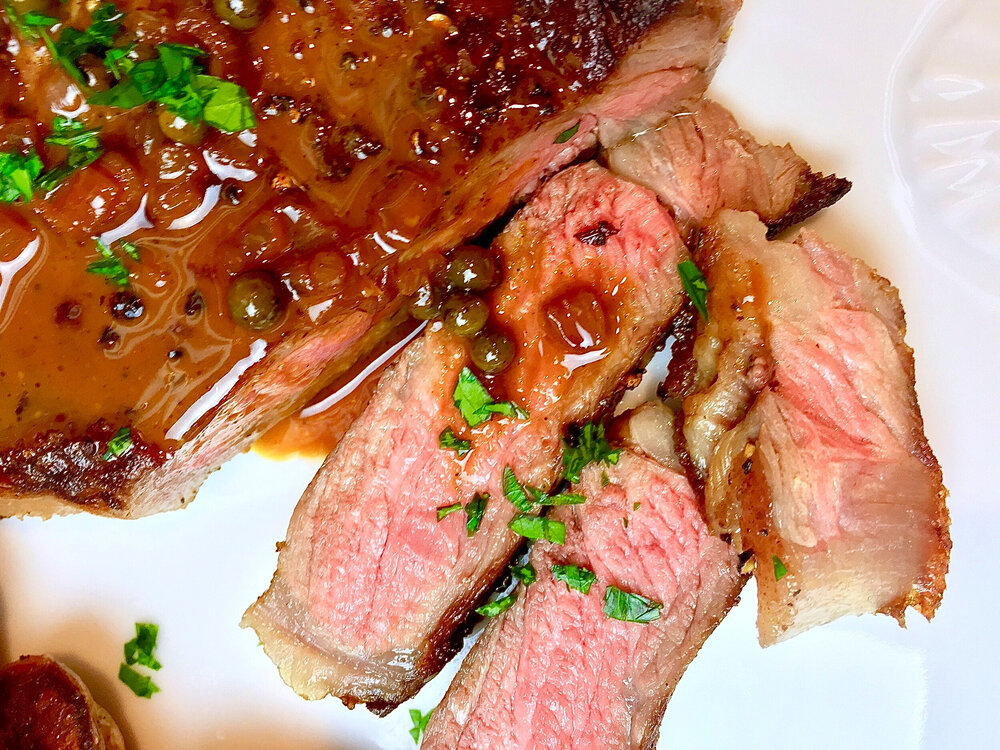
"STEAK AU POIVRE A DEUX"
Serves 2 hungry Valentines
INGREDIENTS
2 boneless NY Strip Steaks
1 Tablespoon good olive oil
3 Tablespoons unsalted butter, room temperature
10 fresh thyme sprigs
6 fresh rosemary springs
1 large shallot, finely chopped
1/3 cup Cognac
1/3 cup demi-glace
1/4 cup heavy cream
1/2 Tablespoon Dijon mustard
1 Tablespoon jarred green peppercorns, drained + rinsed
1/4 cup chopped fresh, Italian flat-leaf parsley
Kosher salt + freshly ground black pepper
Preheat oven to 400 degrees.
Pat the steaks dry with paper towels +, just prior to cooking, generously season all sides with Kosher salt + freshly ground black pepper + press seasonings into steak.
Using a paper towel, wipe the inside of a large, preferably cast iron, skillet with the Tablespoon of olive oil. Place oiled skillet over a high flame +, as pan is heating, spread half the butter on one side of both steaks. When pan starts to smoke, place steaks butter side down in the skillet. Cook for 4-5 minutes, spooning out any excess liquid that accumulates in the pan.
While steaks are cooking, slather the remaining butter on the other side of the steaks. When ready, flip steaks over + top each steak with half of the rosemary + thyme + then slide the pan into the preheated oven + cook an additional 5 minutes for medium-rare. Remove steaks to a cutting board and allow them to rest for 5-10 minutes.
Pour excess fat from the pan (do not wipe it out) + place it back on the stove over med-high heat.
Add shallots to the pan + saute until translucent + tender, scraping up any delicious bits off the bottom of the pan, about 3-5 minutes.
Remove pan from heat + add Cognac (never pour directly from the bottle). If you have a gas stove, return pan to burner, lean back + tilt the pan to ignite the Cognac. If you don't have a gas stove, use a kitchen lighter. The Cognac will flame for a few minutes + then die down at which point you stir in the demi-glace and cream and simmer for 1-2 minutes until sauce thickens slightly.
Finish the sauce by stirring in the mustard + peppercorns until well mixed. Season to taste + serve drizzled over steaks + garnish with chopped fresh parsley.
"ROSEMARY ROASTED GARLIC POTATOES"
Feeds 2-4 hungry people
INGREDIENTS
2 lbs. small potatoes, rinsed with skins on (we used a mix of yellow and purple potatoes)
Good olive oil
3/4 teaspoon Kosher salt
8-10 twists of freshly ground black pepper
3 sprigs of fresh rosemary
2-3 large garlic cloves, smashed + chopped
2 Tablespoons chopped fresh, Italian flat leaf parsley
Preheat oven to 400 degrees.
Cut potatoes in half lengthwise + place them in a single layer on a large baking sheet lined with foil. Scatter rosemary (leaves only) + chopped garlic over sliced potatoes. Drizzle generously with olive oil + season with the salt + pepper. Using your hands, mix potatoes, garlic, rosemary leaves + seasonings until well combined.
Roast potatoes in the oven for 45-60 minutes, until they are crispy + brown. Flip them at least twice during that time so that they cook evenly.
Remove potatoes from oven + toss with fresh parsley + season to taste with additional salt + pepper.

While the presence of Champagne at an event is usually enough to indicate a celebration is at hand, there's another way to kick it up a notch: the art of Sabrage.
Believed to have been invented by Napoleon during the French Revolution, Sabrage is the technique of opening a bottle of Champagne using a saber. Legend has it, as Napoleon and his troops returned home victorious from battle, the townspeople greeted them with bottles of Champagne to show their appreciation and gratitude. Because they were on horseback, it was too difficult to put down the reins to pop the cork, so they used their sabers and voila, the art of sabrage was born! Another version of the story involves the famed Widow (Veuve) Clicquot who possibly gave Napoleon's officers Champagne in return for protecting her land during this time of political unrest.
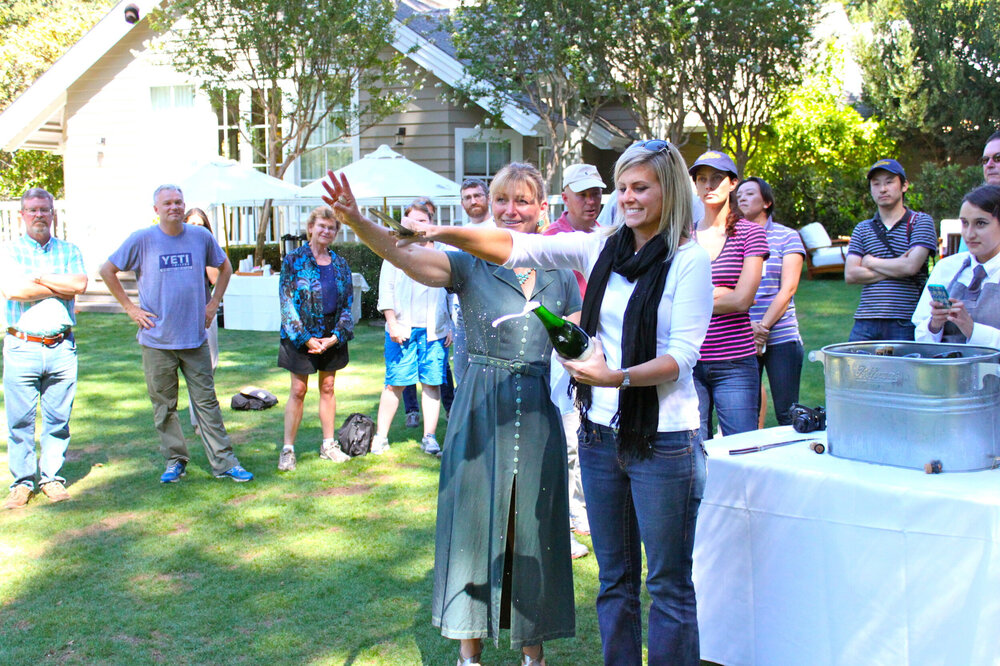
ME PERFORMING SABRAGE AT CAMP SCHRAMSBERG AT MEADOWOOD
Contrary to popular belief, Sabrage is not actually "chopping" the top of the Champagne bottle off. In fact, not much "muscle" is required to perform this technique which essentially utilizes the 6 atmospheres of pressure present in the bottle combined with a quick “whack” from the saber at the weakest point of the bottle, where the seam comes together at the neck. Although there are "Champagne sabers" made especially for this process, Laguiole makes a very nice one, you don't have to use one to perform this technique. The back of a Chef's knife works just as well, just be sure not to use the sharp end of the knife as you can damage the blade.
For a slow motion view of how Sabrage happens, please check out my video below. And while it may look really easy, there are some very important steps to follow in order to perform it safely. Unfortunately, I’ve seen some accidents happen when the bottle wasn’t prepared properly or the wrong motion was used to dislodge the cork from the bottle. One incident even involved stitches so please scroll down for all the important details.
Be sure the bottle of bubbly is VERY cold: If the bottle hasn't been in the refrigerator for at least 24 hours, you may want to rethink using it. Without a properly chilled bottle, you run the risk of the bottle exploding during the process and nothing puts a damper on a party like a shattered bottle of Champagne.
Find the bottle’s seam: Most green Champagne bottles (they are the best to use) have a seam that runs vertically from the neck to the bottom of the bottle where the two halves are joined together. You can easily find it by running your finger around the circumference of the bottle until you find the ridge. This seam is the guide your saber will follow along the bottle, making contact with the neck exactly where it intersects with the seam.
Adjust the wire cage and remove paper/foil from the neck of the bottle: In order to clear the runway for your saber or knife, you'll need to adjust the cage, the wire which surrounds the cork, up one notch so the blade of the saber hits the neck of the bottle cleanly. Simply untwist the wire, slide the cage up one notch to expose the neck, and twist to refasten it around the cork. Be very careful, however, because once the wire cage is loosened, the bottle is “live” and the cork can pop out at any time! You can remove the cage altogether but keeping the cage on not only makes the cork easier to find in an outdoor setting, but also make a nicer presentation. At this point, also remove any foil or paper around the neck so your saber has an unobstructed path to follow.
Hold the bottle properly: There are two ways to hold your bottle of bubbly for performing sabrage: either with your thumb in the "punt" (the indentation in the bottom of the bottle) and your fingers supporting the bottle from underneath, or by simply grasping the bottle around the base. Experiment with each and go with whichever one feels more natural and secure.
Point the bottle away from friends, family, pets, windows and other glass objects: Ideally sabrage is performed outside but when that isn't possible, be sure the bottle is aimed away from people, pets or anything breakable. In the video below, I didn't use as much force as I normally would because I didn't want to take out any ornaments on the Christmas tree, not to mention any of the windows.
Let 'er rip: When you're ready to go, hold the Champagne bottle away from you pointed upwards at a 45 degree angle to the ground and run the blade along the seam, taking a few practice strokes. Then, briskly slide the blade along the seam of the bottle with an "up and out" motion, following through and making good contact where the seam meets the neck of the bottle and the top should pop right off! In the event it doesn’t, regroup and simply try again.
Wipe off the neck of the bottle and serve: Once the deed is done and all the applause has quieted, it's time to enjoy the fruits of your labor! Luckily, the pressure inside the bottle ensures no glass falls into it, however, it's always smart to wipe off the top of the bottle with a kitchen towel just to be sure there's no glass fragments remaining. Then, you're free to serve your guests but no matter what you do, don't ever attempt to drink from a freshly sabered Champagne bottle! The jagged edges are extremely sharp and this gaff will take you from hero to zero (not to mention the emergency room) in seconds flat.
In case you're wondering what the process looks like, below is a video of me sabering a bottle of Taittinger Brut Rosé for our guests on New Year's Eve. As I mentioned previously, I didn't use as much force as I normally would in order to spare the windows and Christmas tree ornaments. I hope you have fun experimenting with the art of Sabrage and remember the immortal words of Napoleon, "In victory you deserve Champagne, and in defeat, you need it."
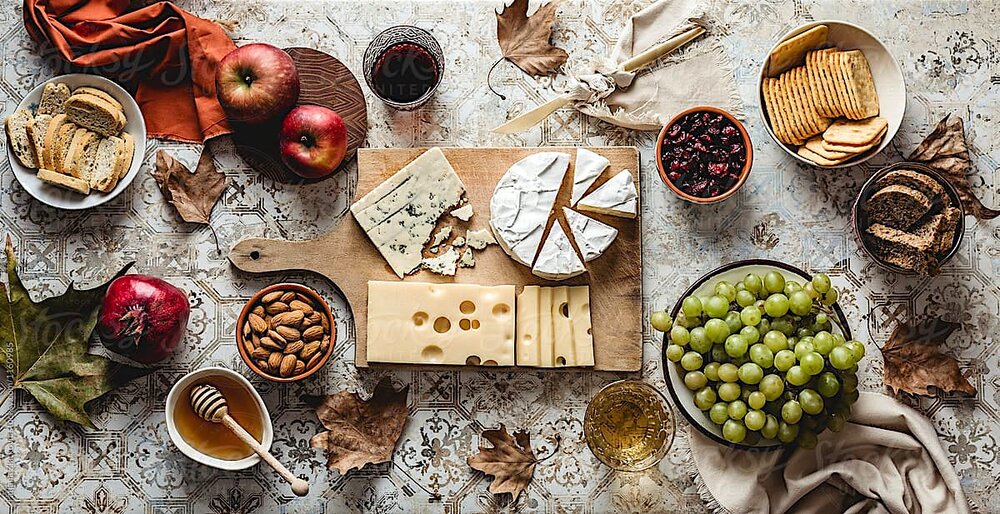
The Holiday Season is the perfect time to hone your wine and cheese pairing prowess! Creamy, comforting and delicious, cheese is synonymous with the Fall and Winter months, and wine can arguably be the perfect accompaniment.
But what wine to serve with that wedge of triple cream Brie, charming Cheddar, or fragrant Epoisses? Here are a few basic tips or “Pairing Principles” as I like to call them, for creating the perfect duo.
The same principle that works for food and wine also works for wine and cheese. If you enjoy particular flavors in a cheese, opt for a wine that mirrors those delicious qualities. For instance, a tangy, acidic fresh goat cheese would be well matched with a zesty, citrusy Sauvignon Blanc. Similar flavors create this fabulous flavor synergy! In addition to fresh goat cheese with Sauvignon Blanc, other examples of this principle include Camembert or Brie with Chardonnay, aged sheep’s milk cheese with sherry, and Emmentaler with Merlot.
Try a crisp, tangy Sauvignon Blanc paired with fresh goat’s milk Fromage Blanc or Chevre. Producers to look for include Paul Cluver (South Africa), Invivo X (New Zealand), Michel Redde (Sancerre) + Round Pond (Napa).
The texture of a cheese is an important window into its flavor and can aid in finding a great wine to match it. For instance, if a cheese is creamy and viscous, like Brie, you would want to match it with a wine with similar qualities, say a creamy, buttery Chardonnay. Or, if you’re in the mood for a semi-hard cheese like cheddar, a medium-bodied Zinfandel would probably work best.
Try Manchego and Rioja, Gruyère and Gewürztraminer and/or washed-rind cheeses and Cabernet Franc for some classic examples of this principle.
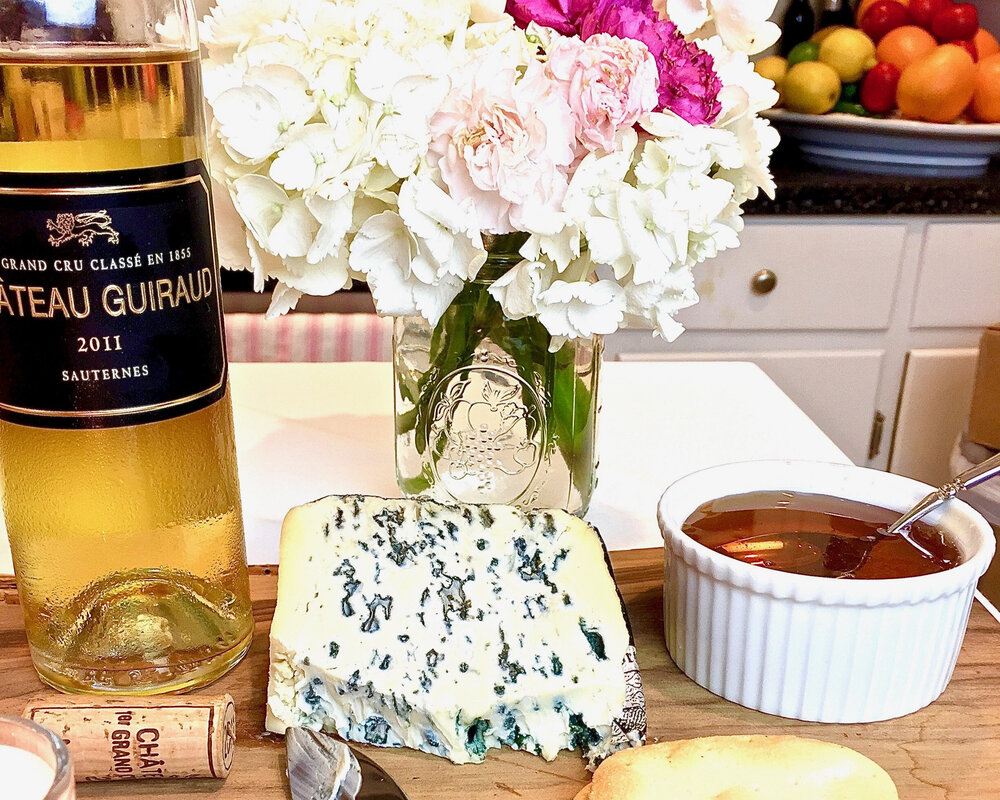
This may appear contrary to the first pairing tip, however, if you are a fan of sweet and salty or sweet and savory flavors together, this might be THE principle for you! Choosing opposing flavors in wine and cheese can make for some delicious flavor combinations. If you have a salty cheese, then it will generally pair well with a sweet wine – as long as the saltiness and sweetness are in balance.
Classic “opposite” cheese and wine pairings include Roquefort and Sauternes and Stilton and Port.
While these three Pairing Principles can serve as a guide for establishing some wonderful wine and cheese pairings, the best practice is to experiment and discover what truly pleases YOUR palate! What are some of your favorite wine and cheese pairings? Please let me know in the comments section below!
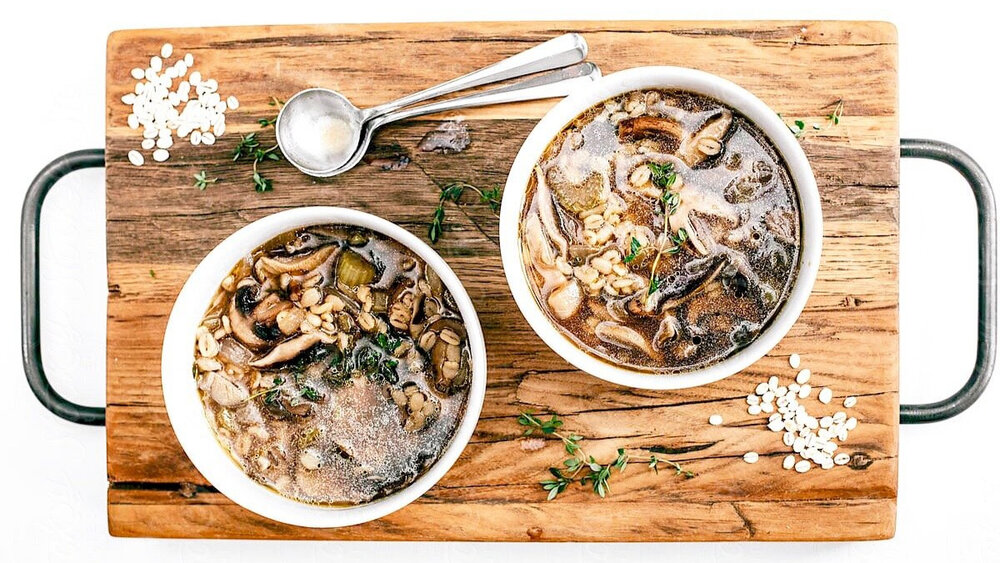
Folks, next time a cold front (or "cool" front if you're in South Florida) rolls into town, please do yourself a favor and put this delicious recipe for Porcini Mushroom, Thyme, & Barley Soup at the very TOP of your list! It is literally the culinary equivalent of a cozy, cashmere blanket on a chilly Fall night.
The combination of dried porcini and cremini mushrooms gives this soup a delightful depth of flavor and texture that is sure to make your taste buds sing. And as a confirmed carnivore I have to admit, I didn't even miss the meat!
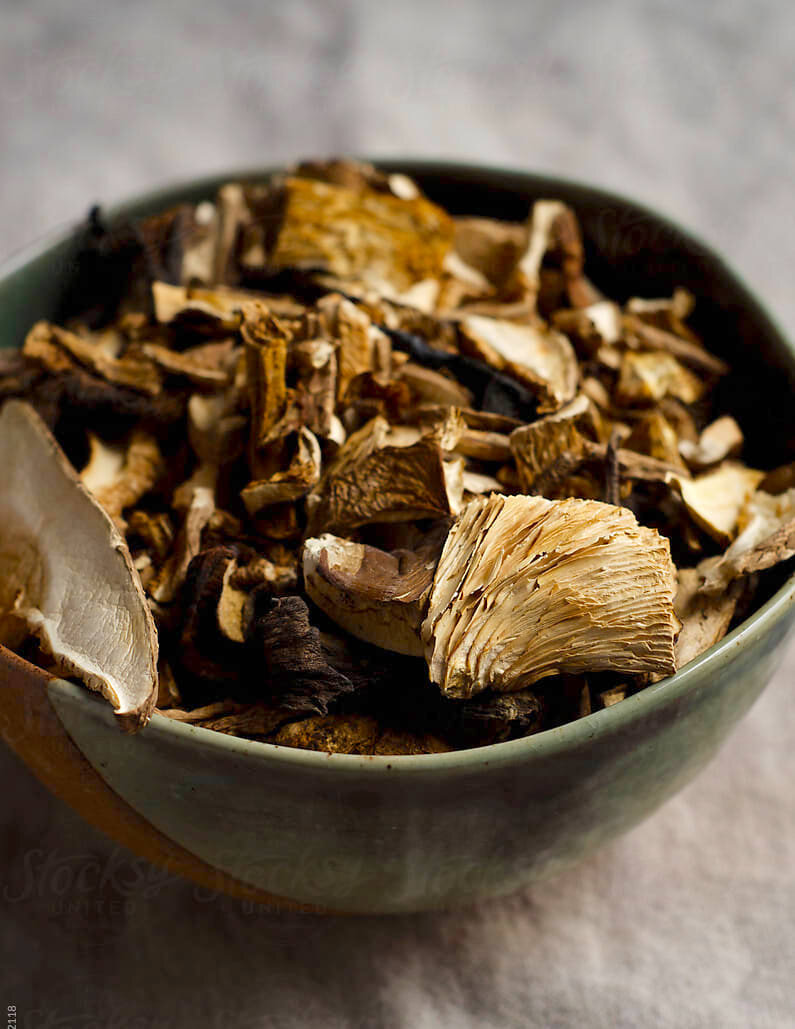
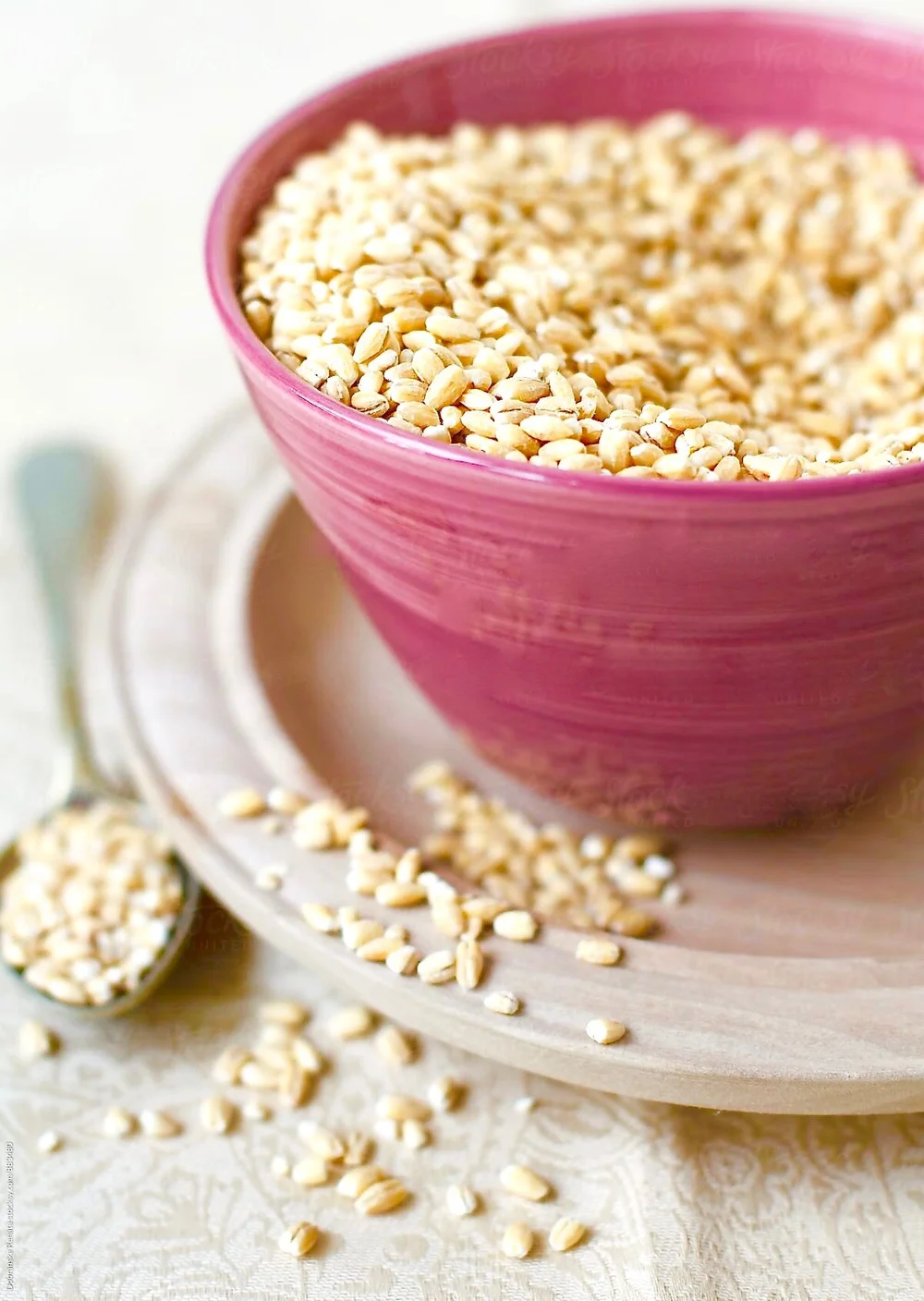
I also think this soup beautifully demonstrates the concept of "umami" which refers to "a savory taste" and is now considered one of the five basic tastes along with sweet, sour, bitter and salty. The starch from the barley also creates a wonderful creaminess as the soup cooks and the thyme lends the perfect contrast of "brightness" to the earthy, savory flavors.
This extremely comforting soup is sure to get you through many a chilly night and is a wonderful way to savor the season without a lot of work slaving over a hot stove! For more Fast + Fabulous recipes that take around thirty minutes to make, please click here.
PRINT RECIPE"PORCINI MUSHROOM, THYME + BARLEY SOUP"
Author: Stephanie Miskew | The Glamorous Gourmet
Serves: 4-6
Ingredients
2 Tablespoons good olive oil
2 large shallots, finely chopped
1 1oz. package dried porcini mushrooms
2 garlic cloves, minced
1 lb. cremini mushrooms, trimmed and sliced
2 quarts beef broth
5 sprigs fresh thyme
1/2 cup pearled barley, rinsed
Kosher salt
Freshly ground black pepper
1/3 cup chopped fresh Italian parsley
Instructions
In a small bowl, cover dried mushrooms with 2 cups of boiling water and soak, for 20 minutes using a small plate to keep them submerged. Strain and reserve the liquid and give the mushrooms a rough chop. Set liquid and mushrooms aside.
Heat olive oil in a soup pot over medium-high heat. Add shallots and garlic and saute until fragrant, about 2 minutes.
Add the cremini mushrooms and cook until they release their liquid, approximately 5 minutes. Add reserved mushroom liquid, reconstituted porcini, beef stock and thyme and bring to a boil. Add barley and reduce to a simmer.
Cook soup partially covered until barley is tender, 35 to 40 minutes. Season with Kosher salt and pepper. Stir in parsley before serving.
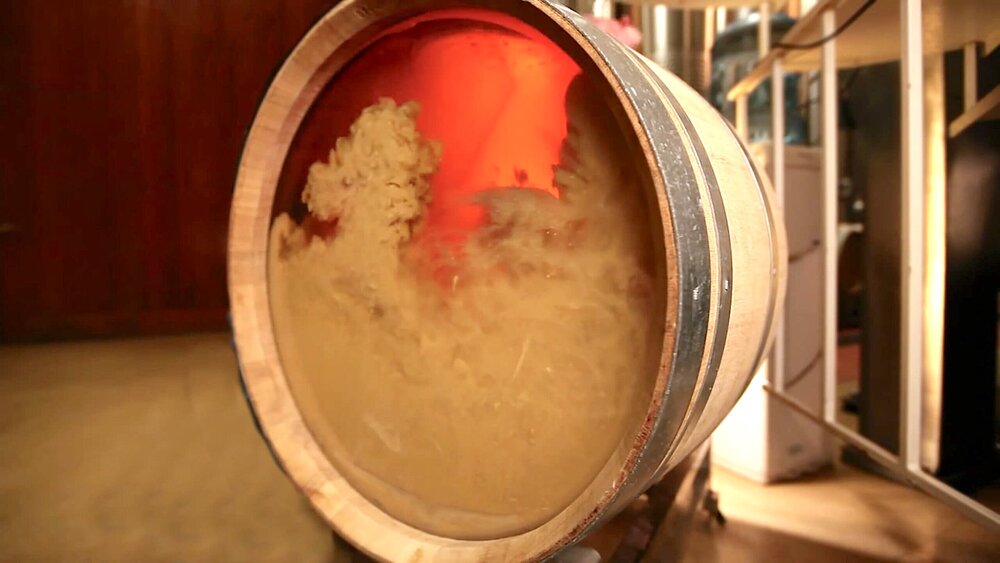
Don your beret and grab a glass of Chardonnay, my fellow wine lovers - it's time for a little French lesson for our latest Wine Word of the Week!
Bâtonnage (ba-tun-AJH) is a French term which refers to the stirring of a wine with a bâton (pictured below) while it is being fermented sur lie, or "on the lees." Lees is a French term that refers to the dead yeast cells and other particulate matter that collects at the bottom of the barrel as a normal byproduct of fermentation. Allowing the wine to remain in contact with these cells imparts a fuller, richer body and more complexity to the wine.
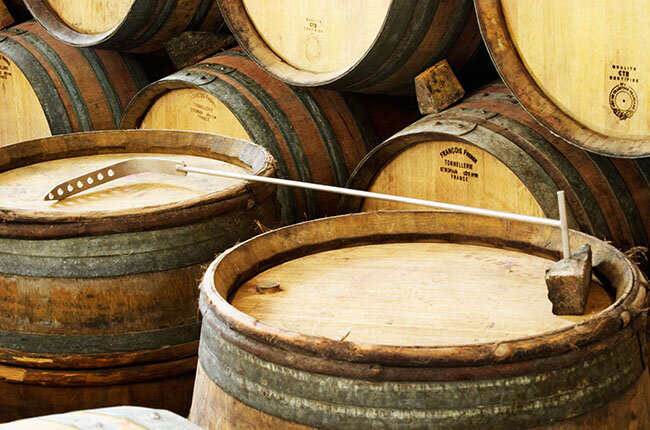
Stirring or bâtonnage facilitates this process by maximizing the wine's exposure to the lees (see video below). The extent to which this technique is employed is determined by the winemaker and the style of wine he or she is trying to produce. The more contact the wine has with the dead yeast cells, the more effect it will have on the wine. Ultimately the lees are filtered out of the wine before it is bottled once it has completed its vinous mission.
Because they are intrinsically linked, you will usually see the terms "sur lie" and "bâtonnage" used together. These techniques are best known for their role in producing white wines such as White Burgundy as well as New World incarnations of the Chardonnay grape.
I hope you enjoyed this Wine Word of the Week, to view previous installments of this segment please click here. And if YOU have a wine word you'd like to learn more about, please let me know in the comment section below - thanks!
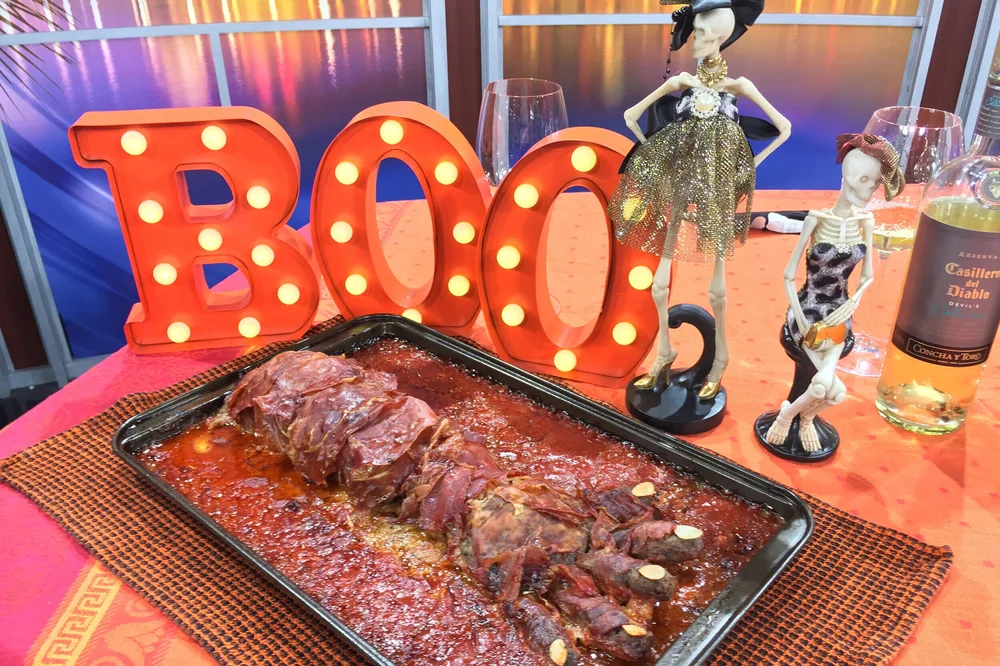
Double, double toil + trouble; fire burn + cauldron bubble!
If you enjoy getting in the Halloween spirit as much as I do, this recipe for Savory Severed Arm in Marinara Sauce will be a hands-down favorite! And if you’ve scrolled through the photos and are a little skeptical, let me assure you - it is every bit as delicious as it is gruesome so please don’t be put off by its gory appearance. In fact, I’ve been making “the arm,” as its come to be known, for about eight years now for family and friends and every time I serve it, there’s never a scrap left!
And while we’re foregoing our usual Halloween gathering due to the pandemic, I’m still making “the arm” for the Hubs + pups and I also thought this would be the perfect year to revamp this post since I haven’t in quite some time. So please enjoy the new and improved, super gory, updated photos that are very much in keeping with my glamorous, brand new website.
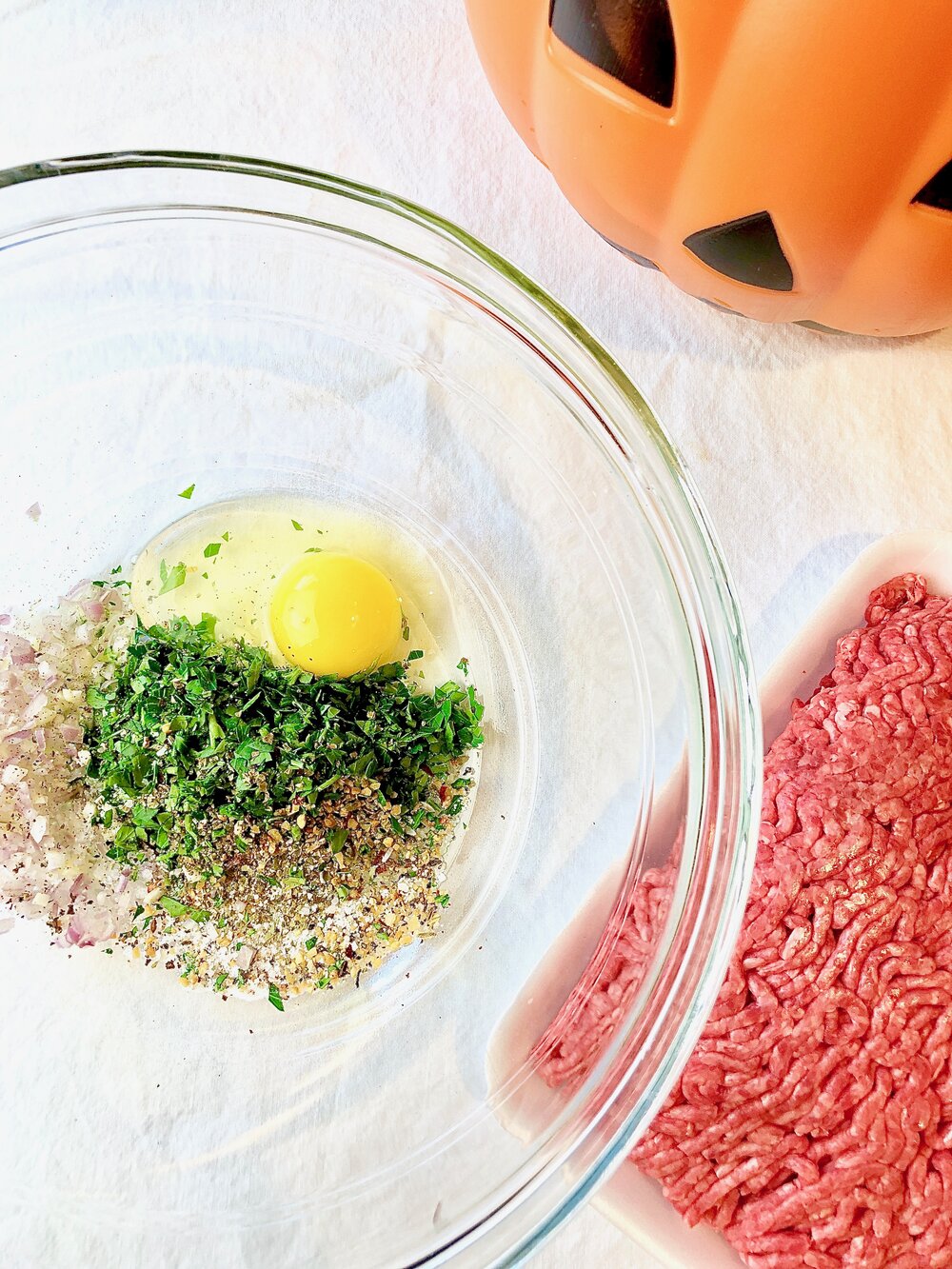


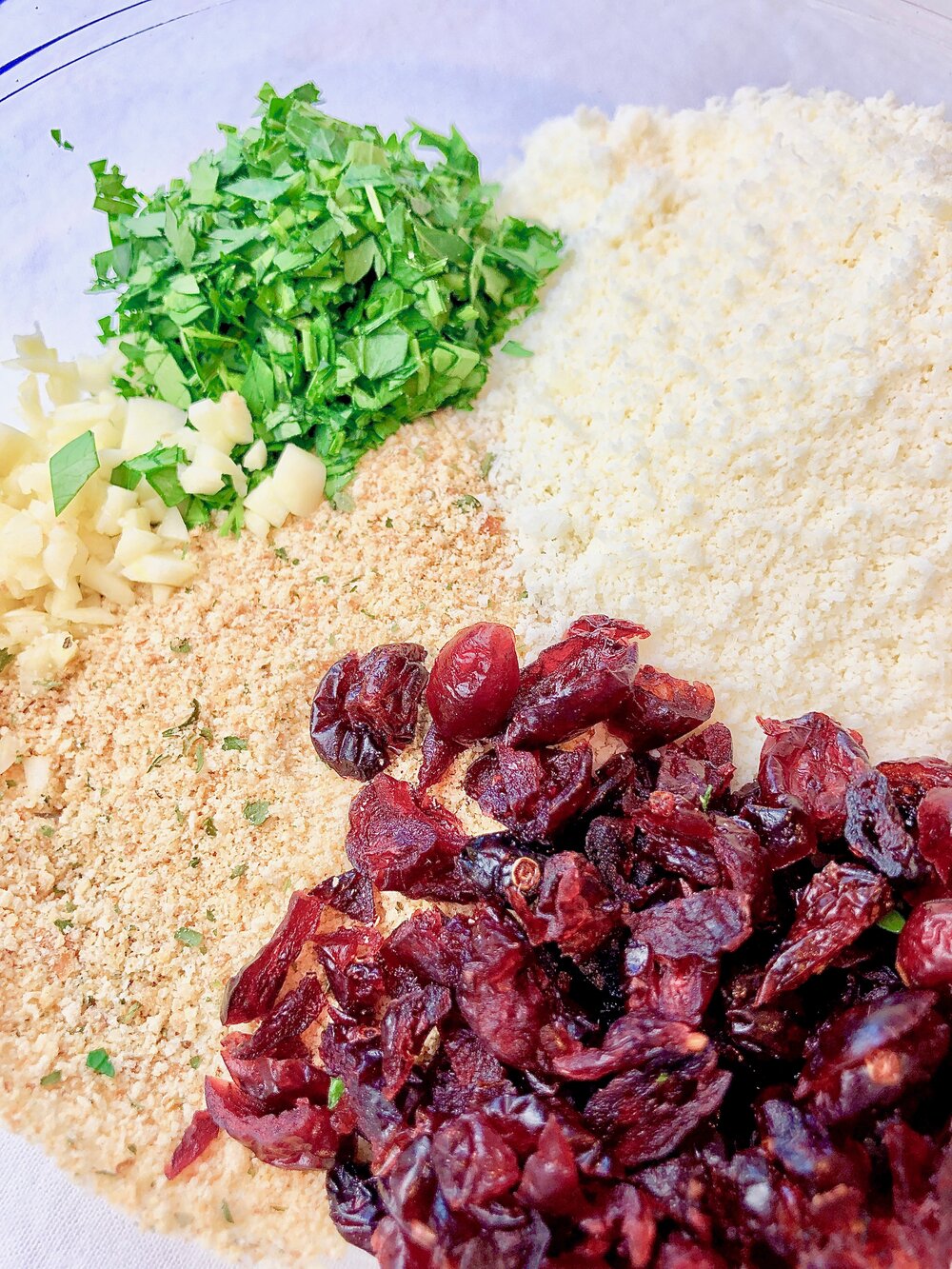
I first saw this recipe on "Nadia G's Bitchin' Halloween Special" many years ago and it is one of the few dishes I've ever made that can be described as simultaneously revolting and delicious. Butterflied flank steak, Italian cheeses and bread crumbs are rolled up to form an “arm” while the hand consists of a ground beef patty seasoned with delicious spices. Once formed, the entire thing is then covered with thinly-sliced prosciutto which, when cooked, resembles the most horrid-looking monster arm, covered in crispy burnt flesh. It IS Halloween after all!
Please take note, this recipe is a tad time intensive and I’ve made adjustments such as using pre-made marinara sauce that definitely cuts down on the cooking time. You can also assemble the arm earlier in the day and pop it in the fridge until you’re ready to cook it. You will also need some kitchen twine to tie up the arm as it roasts so be sure to pick some up at the store. Just be sure to allow some time for it to come to room temperature before searing. And the ground beef mixture needs to sit for about an hour before forming the hand and fingers so please plan accordingly.
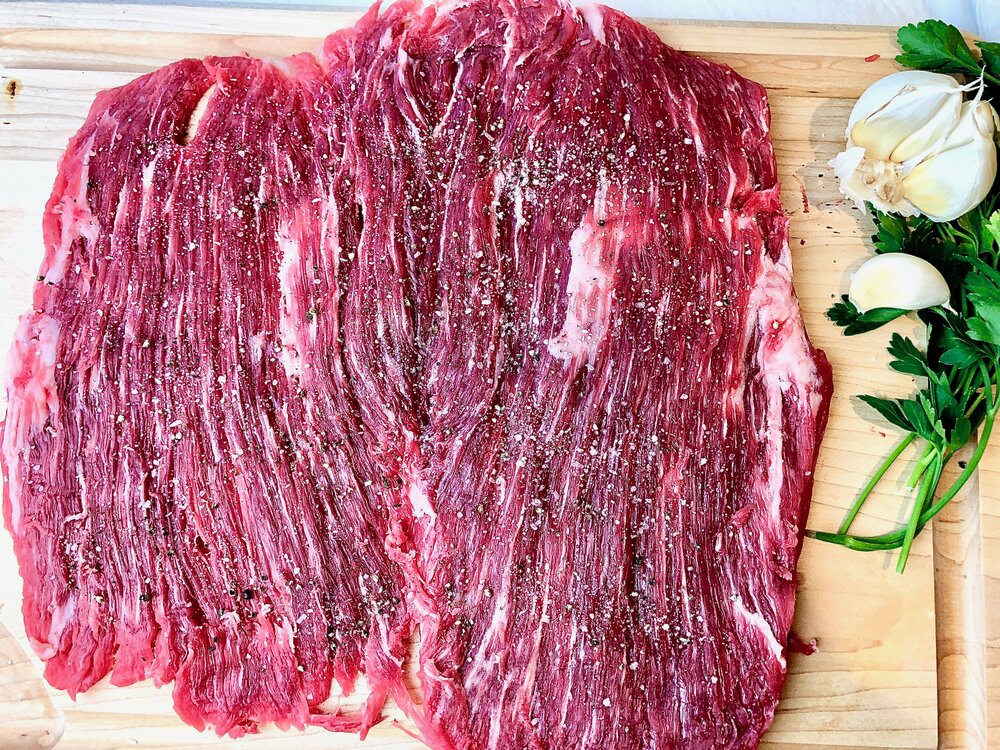
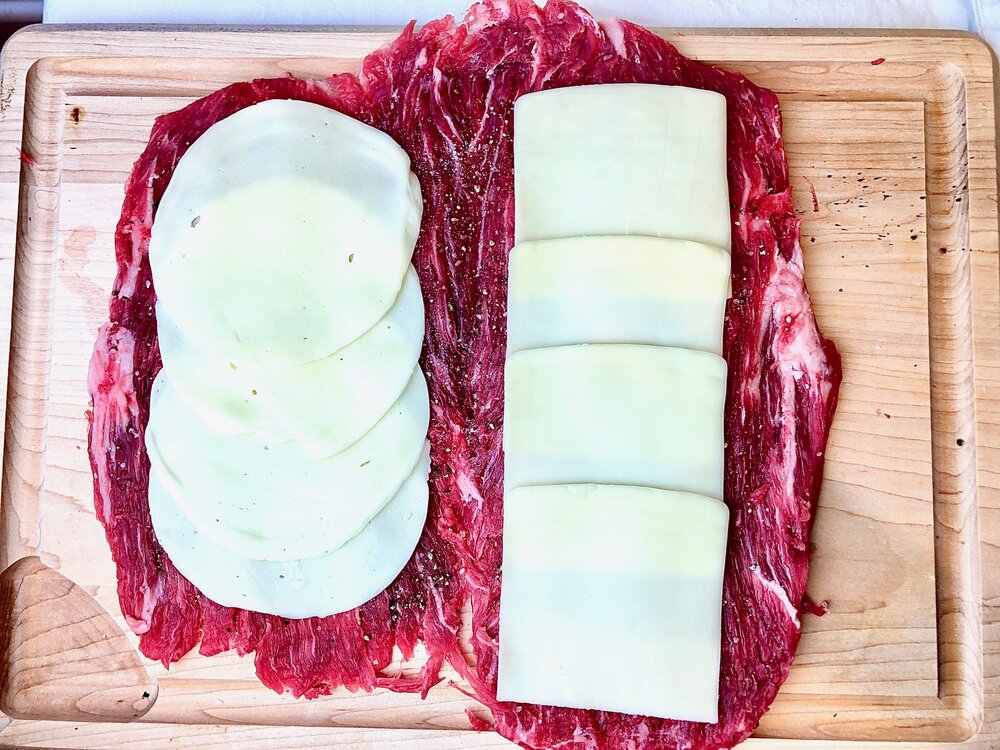
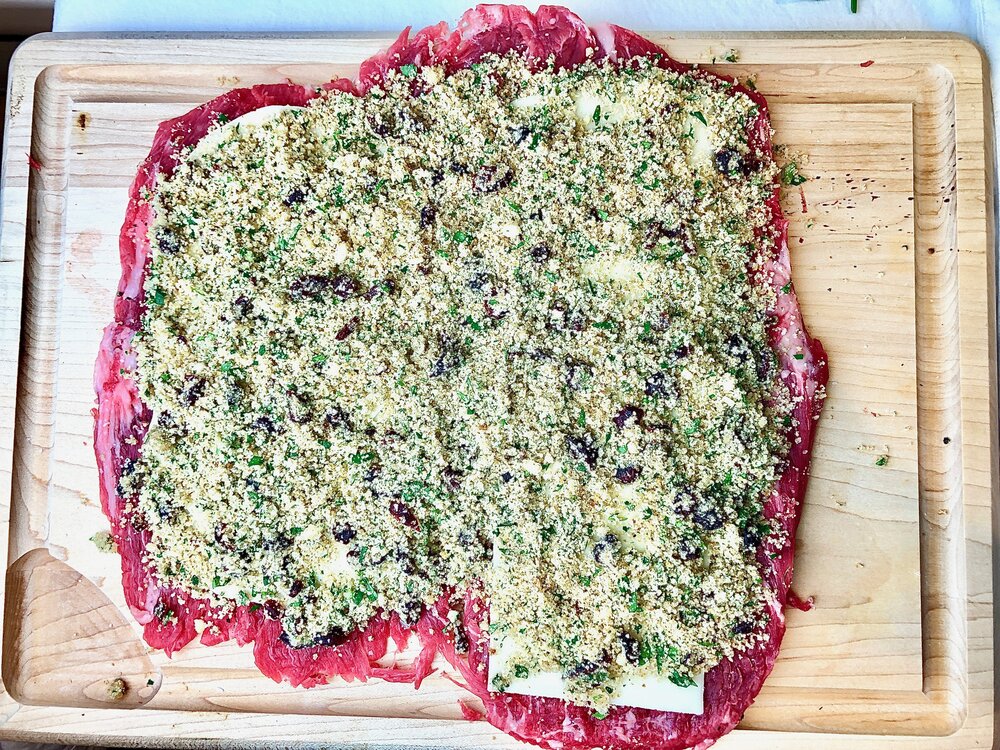
For aesthetics, I finished the hand with sliced almond "fingernails" which made the meaty, gory arm even more creepy. And be sure to pour the marinara sauce around the arm not over the arm, you want the prosciutto to be dry so it gets nice and crispy as the arm bakes. And although it looked positively hideous when it came out of the oven, it always receives rave reviews from my guests and there’s never a "fingernail" or crumb of the arm left at the end of the night.
And for you wine lovers hankering for a special bottle to pair with your Savory Severed Arm with Marinara Sauce, a full-bodied, food-friendly red wine would be a perfect choice. My recommendations include:
First + foremost an earthy, tart red-cherry infused Chianti Classico Riserva given the arm’s Italian origins - producers to look for include Banfi, Fattoria Felsina + Antinori.
A fruity, full-bodied Australian Shiraz - producers to look for include Chateau Tanunda, Yalumba + Mollydooker.
A spicy, juicy Argentine Malbec - producers to look for include Alta Vista, Tikal + Bodega Catena Zapata.
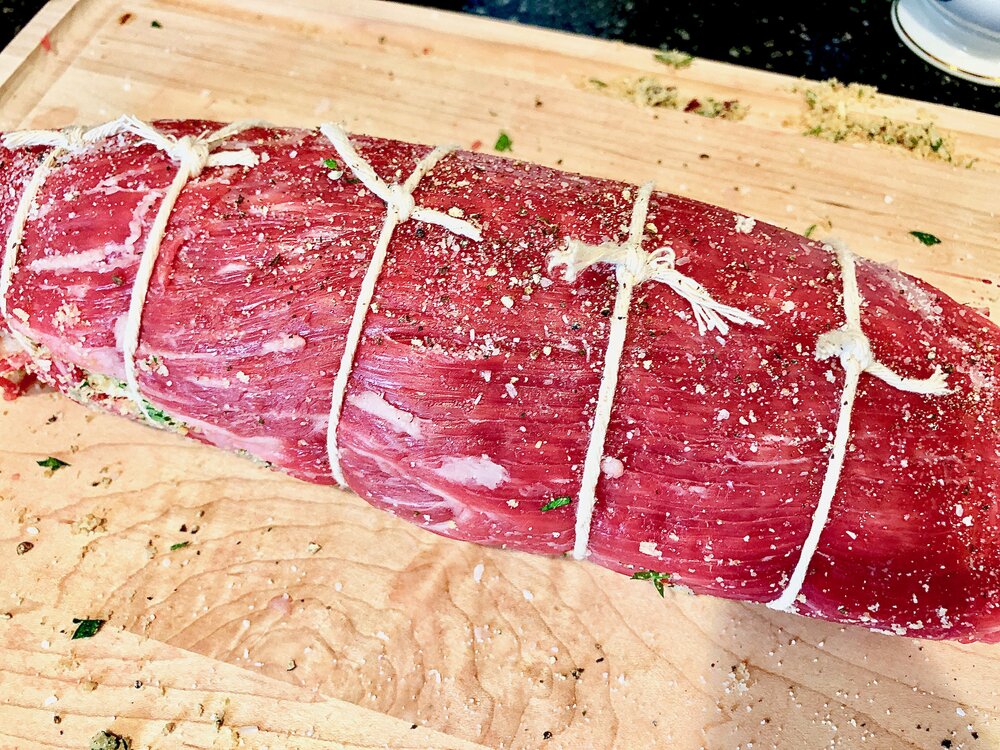
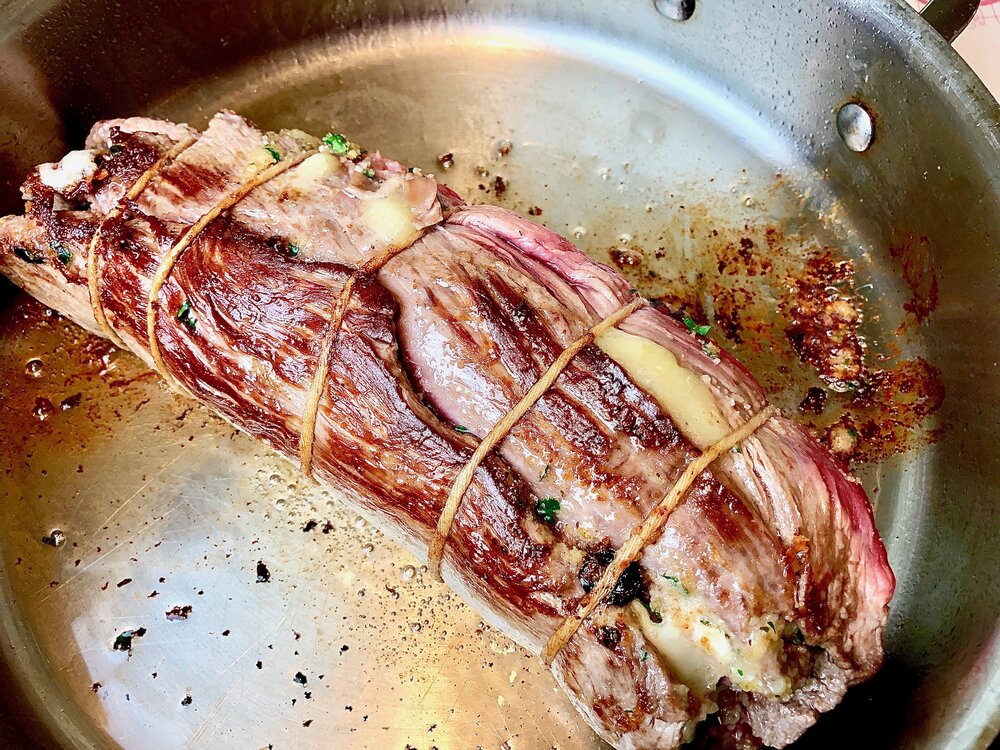
If you happen to be looking for other recipes to round out your Halloween feast, here are a few more from Nadia's Halloween special: Worm and Maggot Salad, Double-Decker Coffin Sandwiches and Creepy Bocconcini Eyeballs with Prosciutto "Flesh" & Blood Salsa. And while these recipes are also delicious, "the arm" is definitely the pièce de résistance! Please scroll down for the recipe for the Savory Severed Arm in Marinara Sauce and you can find the other recipes from Nadia's Halloween Special by clicking the recipe names above.
Cheers to a very Happy, Delicious + Safe Halloween + please scroll down for recipe! xo
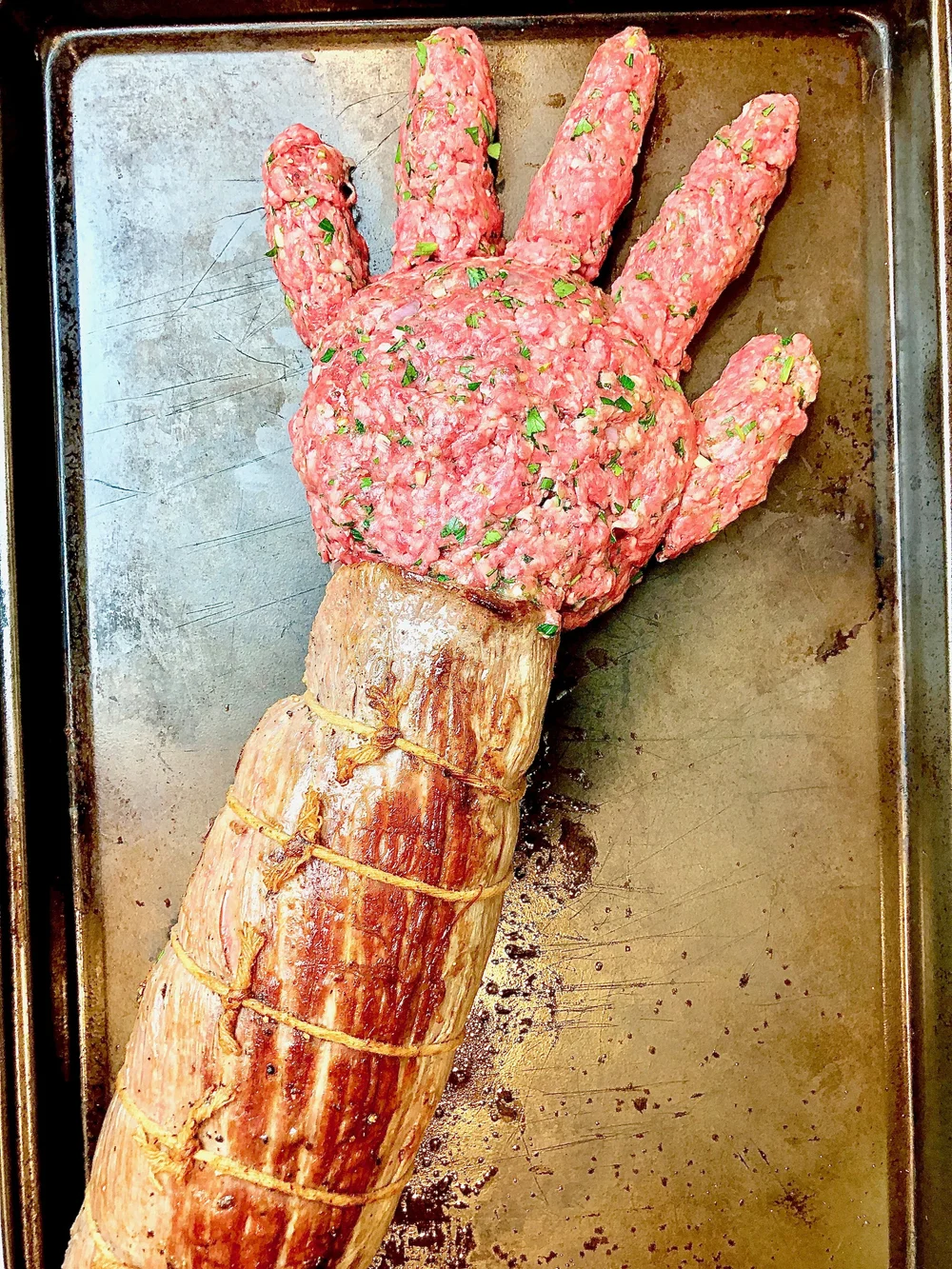
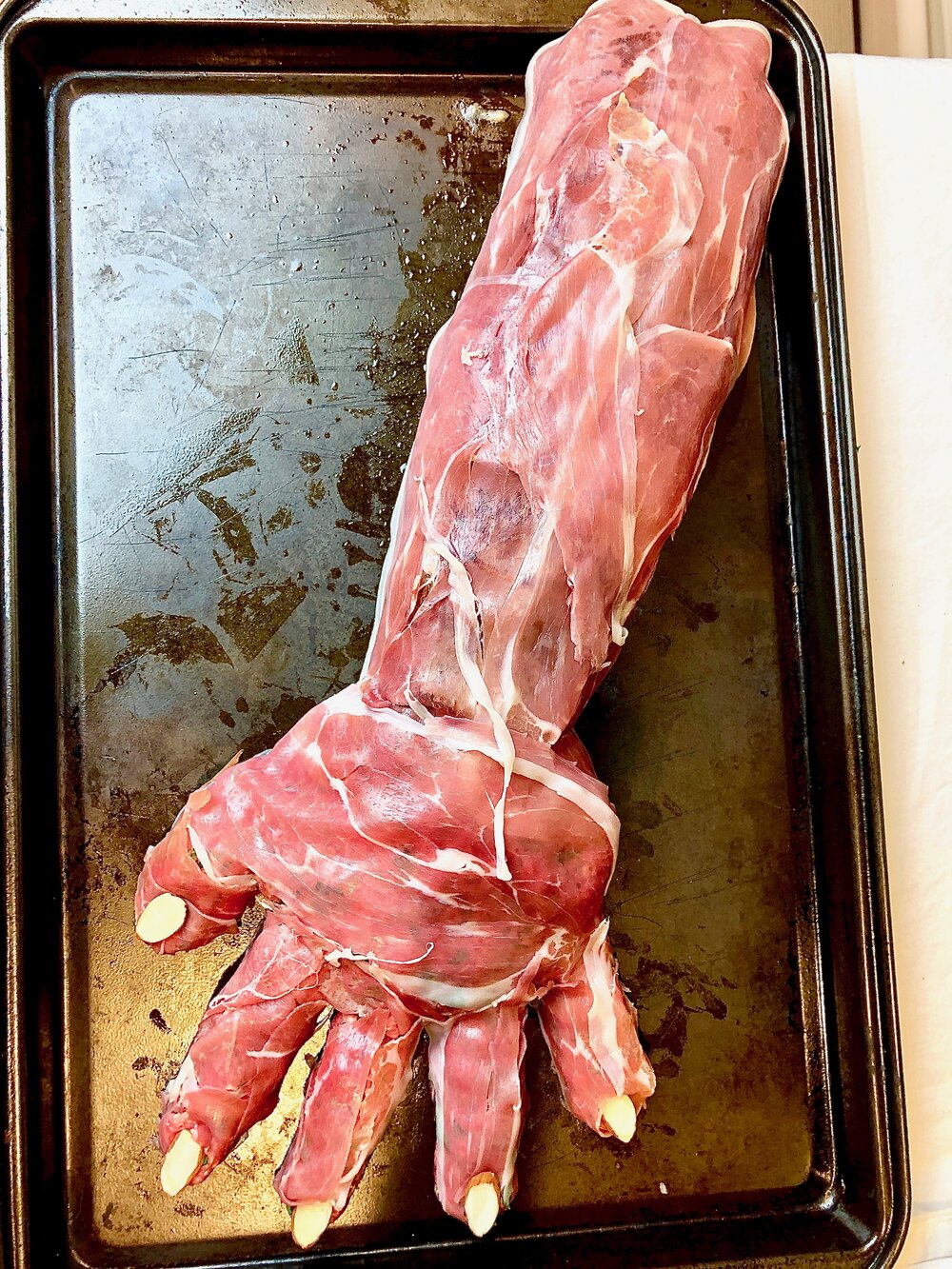
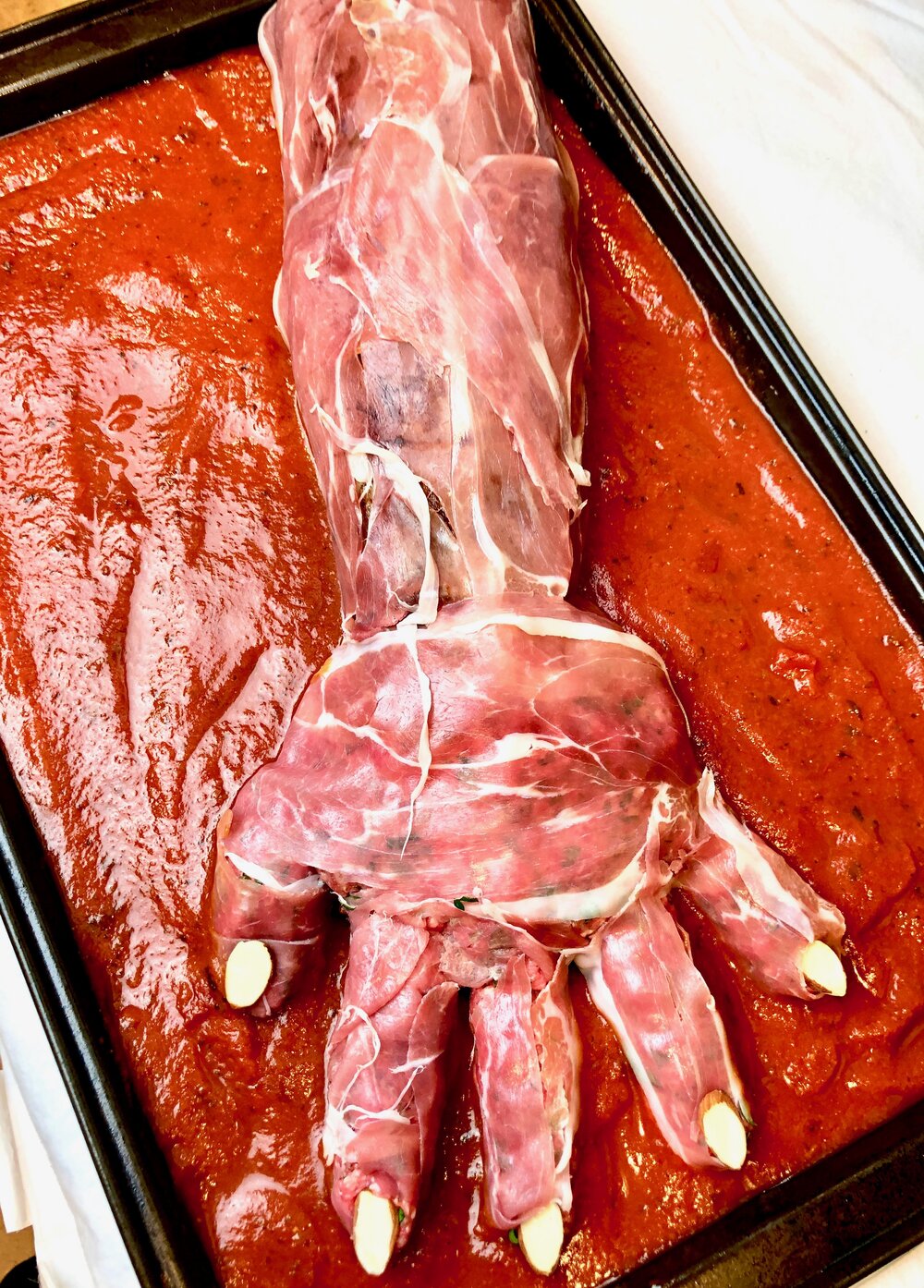
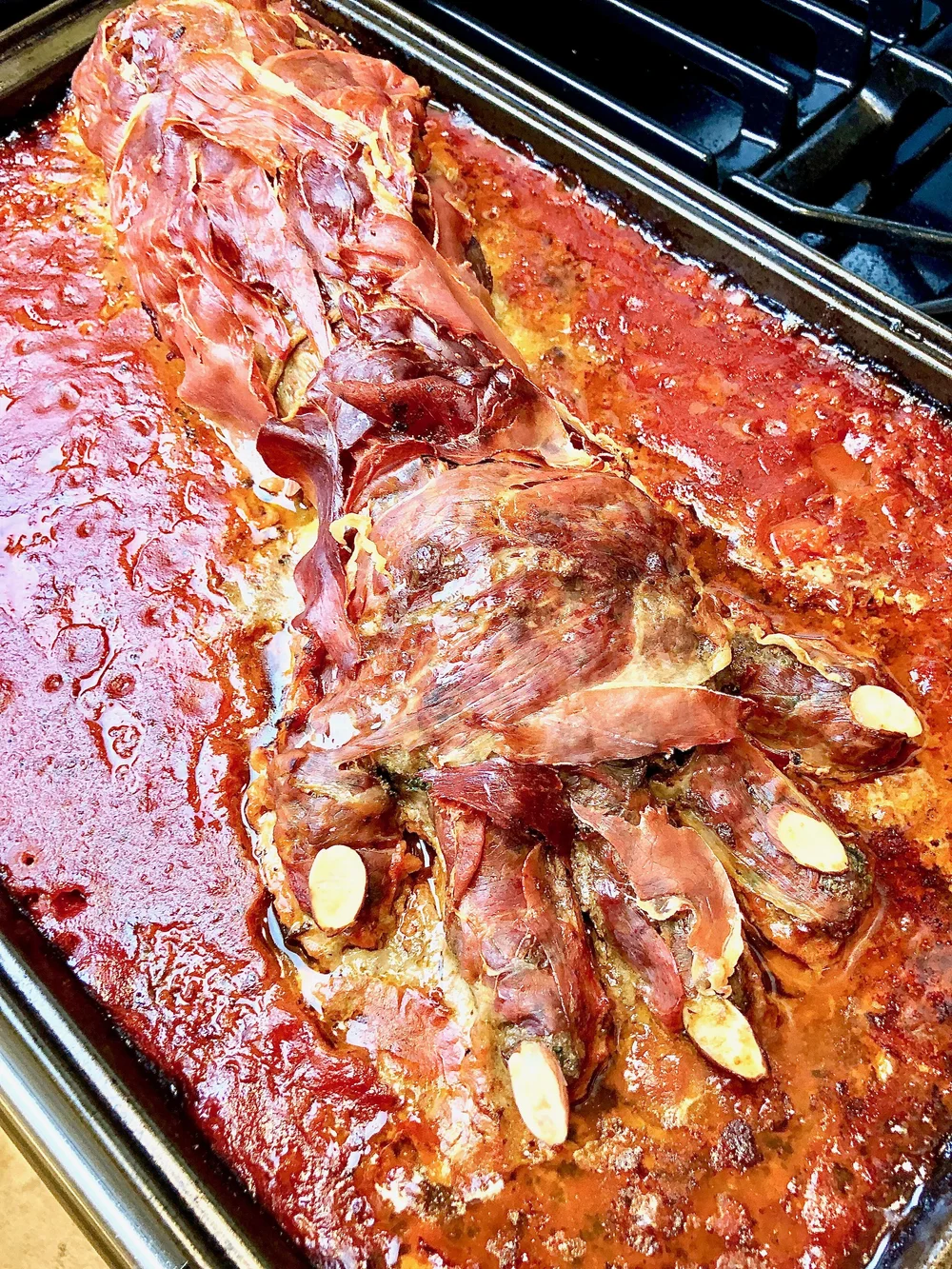
"SAVORY SEVERED ARM IN MARINARA SAUCE"
Adapted from Nadia G's Bitchin' Kitchen
Serves 6-8
For the Hand:
1/4 cup fresh Italian flat-leaf parsley, minced
1 teaspoon steak spice
1/2 teaspoon red chili flakes
1/2 teaspoon dried oregano
1 bunch fresh chives, chopped
1 egg
1 clove garlic, minced
Kosher salt + freshly ground black pepper
1 1/2 pounds ground beef
Sliced almonds for fingernails
For the Arm:
1/2 cup Italian-style breadcrumbs
1/2 cup pecorino cheese, grated
1/4 cup dried cranberries, chopped
2 tablespoons fresh flat-leaf parsley, minced
2 cloves garlic, minced
5 tablespoons olive oil
1 1/2 pound flank steak
Kosher salt & freshly ground black pepper
4 slices mozzarella cheese
4 slices provolone cheese
4 ounces sliced prosciutto
45 oz. jar of marinara sauce (Prego works perfectly)
INSTRUCTIONS
For the hand: Mix together the parsley, steak spice, chili flakes, oregano, chives, egg, garlic and some salt and pepper in a bowl. Add the beef and mix together for 30 seconds to season the beef. Don't over-mix. Cover and refrigerate for 1 hour.
For the arm: Preheat the oven to 350 degrees F. Mix together the breadcrumbs, grated pecorino, cranberries, parsley and garlic in a small bowl. Quickly mix in 2 tablespoons of olive oil and set aside.
Lay the flank steak flat on a cutting board and with a sharp Chef's knife, butterfly the steak by slicing it in half lengthwise but leaving it connected at the outermost edge so it opens like a book (for a great video on how to do this, please click here). Sprinkle inside with salt and pepper and then lay the mozzarella and provolone slices on the inside of the freshly butterflied steak. Add the breadcrumb mixture and roll up the steak, tying with butcher's twine at each end and in the middle to keep the width of the arm as uniform as possible.
When ready to cook, sprinkle the entire exterior of the roll with salt and pepper and heat the remaining 3 tablespoons of olive oil in a skillet over medium heat. Brown the arm roll on both sides, approximately 10 minutes + then remove the meat with tongs and place in the center of a baking sheet. Cover the arm with half of the prosciutto slices so that it looks like skin.
Assembly and cooking: Remove the hand mixture from the refrigerator and make a large patty to resemble the palm of a hand and place it at the end of the arm on the baking sheet. Cover with some of the remaining prosciutto. Roll out 5 fingers with the remaining beef mixture, using your own hand as a guide. Cover each finger with the remaining prosciutto and then place a sliced almond where the fingernail should be.
Cook: In order to see the arm more clearly, pour the marinara sauce all around the arm on the baking sheet rather than over it. It's nice to let the prosciutto "skin" get nice and crispy! Cover with foil and bake for 45 minutes. Then remove the foil and bake uncovered until tender, another 45 minutes.